With the release of new drivers and new games, plus the request of many readers, it’s time for an updated look at the Radeon RX 7900 XTX vs. GeForce RTX 4080 rivalry with fresh benchmarks as you may be planning on buying one of these GPUs for Christmas, or are hoping to secure a Black Friday deal next month. Whatever the reason, we have an abundance of new data for you.
As of writing, you’re looking at having to pay at least $910 for a Radeon 7900 XTX, with most models priced closer to the $1,000 MSRP. For instance, the PowerColor Hellhound is priced at $910, while the Sapphire Pulse is available for $920 at Newegg, with significant discounts on these models.
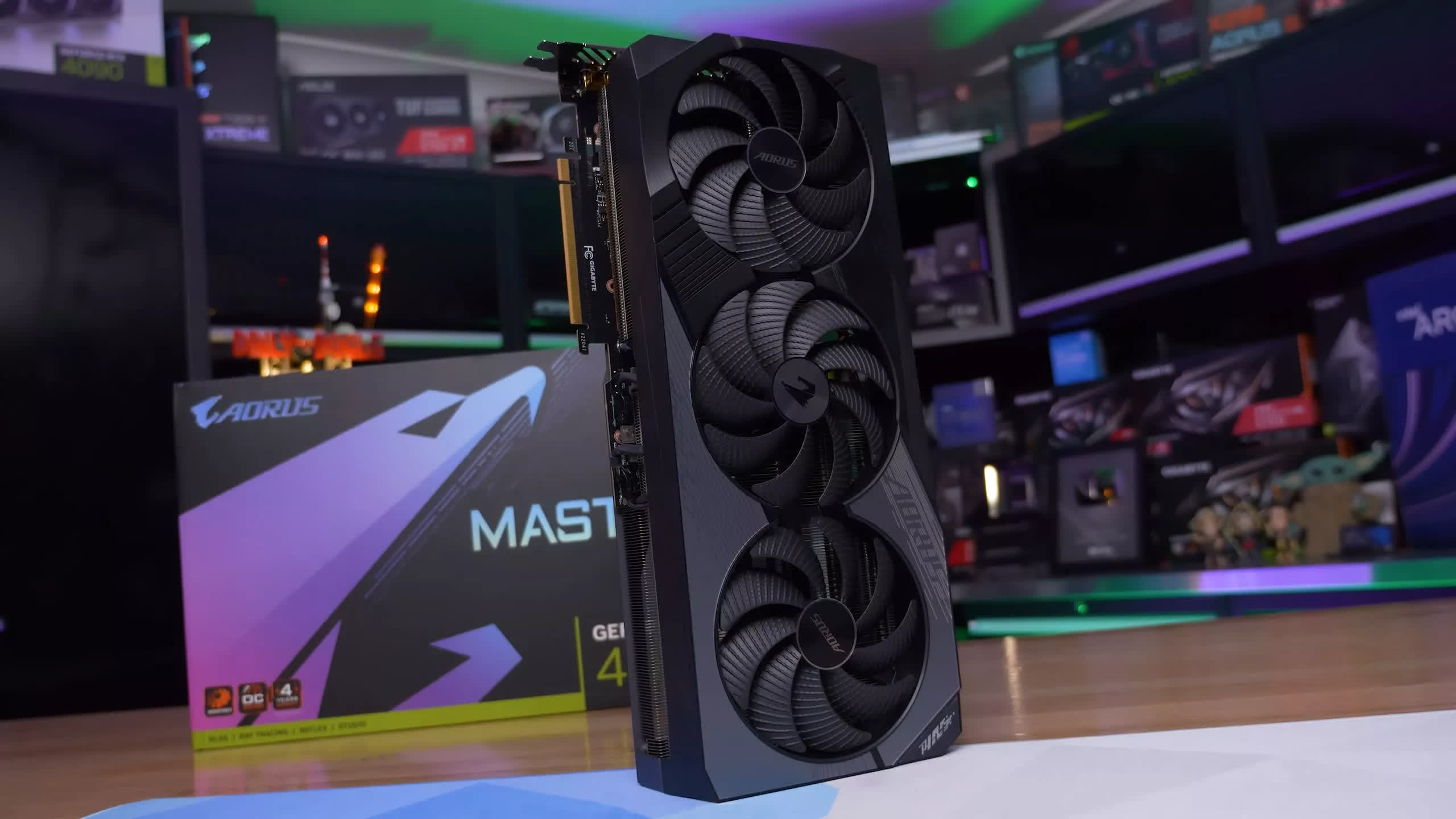
For the GeForce RTX 4080, prices start at about $1,100 for the least expensive model. The Gigabyte Eagle, for instance, is priced at $1,090 and the OC version is $1,100, while MSI’s Ventus is currently $1,180. We observe that the vast majority of RTX 4080s are still priced close to the $1,200 MSRP.
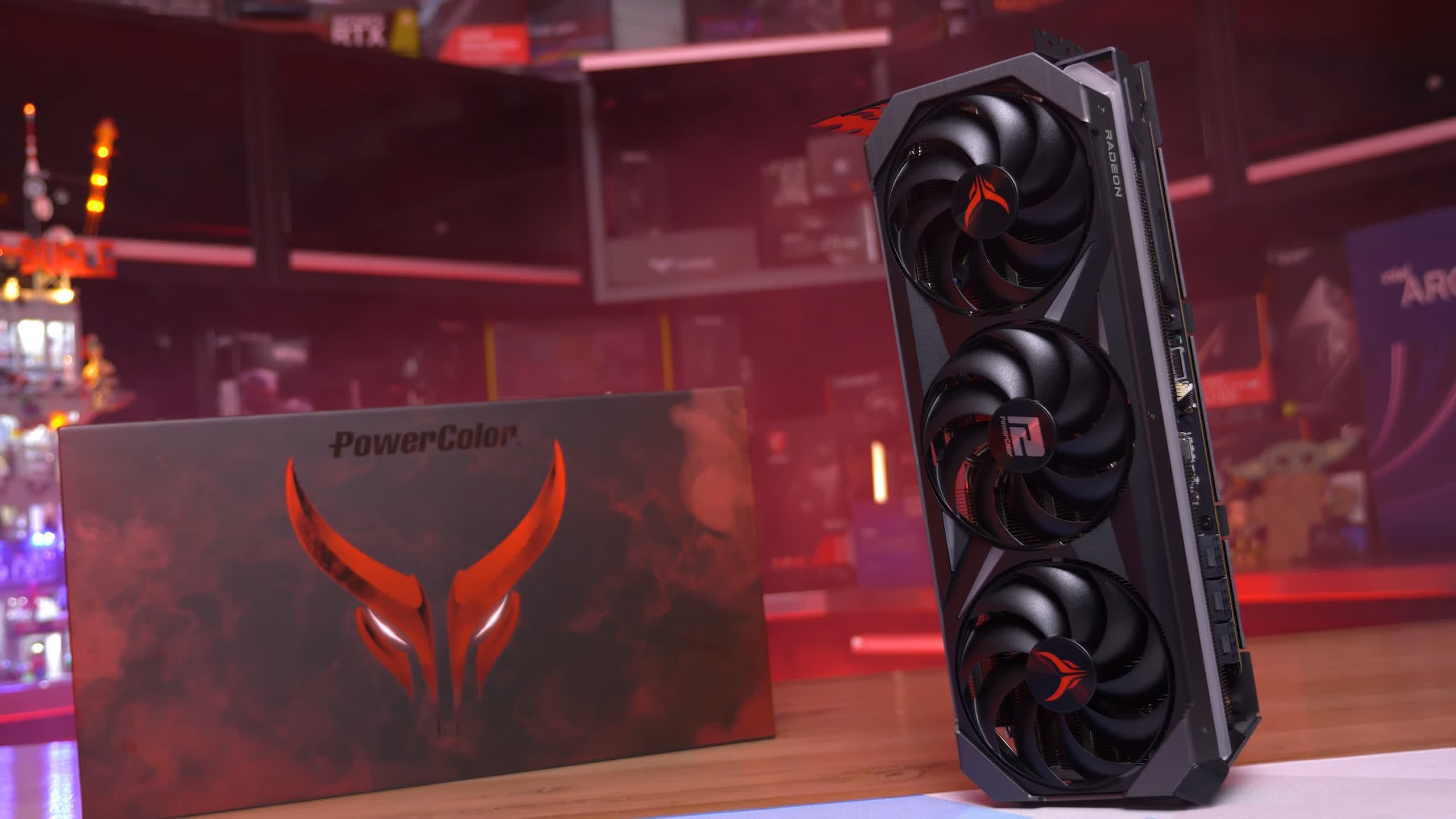
This means that the Radeon GPU is typically ~15% less expensive in the current market, aligning with the expected MSRP for each model. The overall value perspective hasn’t shifted much, but with updated drivers and new games in the mix, it’s intriguing to see the performance dynamics.
For our tests, we’re using our Ryzen 7 7800X3D test system with 32GB of DDR5-6000 CL30 memory. The display drivers used were Nvidia’s Game Ready 537.42 and AMD’s Adrenalin Edition 23.9.3. We reckon it’s about time we jumped into the data, so let’s do it…
Benchmarks
First, we’re examining The Last of Us Part I, a game that has been extensively updated since its initial release. Using the ultra-quality preset, the performance is solid, with both GPUs performing closely. The RTX 4080 was only 4% faster at 1080p, while the 7900 XTX took the lead with a 4% advantage at 1440p, growing to 8% at 4K.

Upon enabling upscaling with the quality DLSS and FSR modes, we observed unusual scaling behavior with the Radeon GPU. After verifying the data multiple times, we consistently found that the 7900 XTX showed no additional frames at 1080p with FSR enabled, mirroring the performance of the native result. However, the RTX 4080 experienced an 18% boost with DLSS at 1080p.
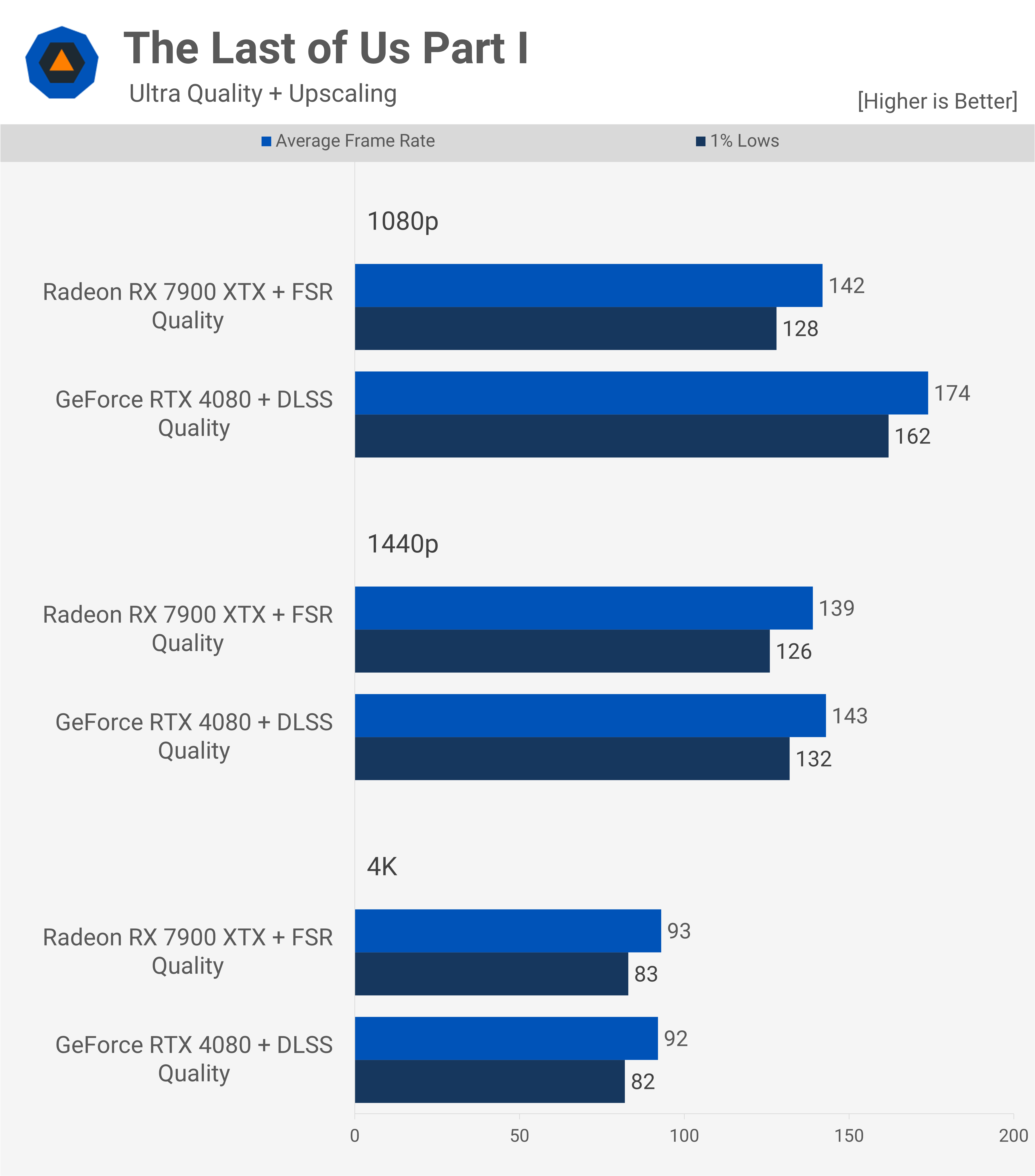
At 1440p, FSR appeared to work as anticipated, enhancing the 7900 XTX’s performance by 22%. The 4080 saw an even larger boost of 30%. At 4K, both GPUs delivered similar performance, slightly above 90 fps. There seems to be an issue with FSR in The Last of Us Part I.

For Remnant II and using the ultra preset, the 7900 XTX outperformed, surpassing the RTX 4080 by 13% at 1080p, 17% at 1440p, and 22% at 4K. Both GPUs displayed good performance, particularly notable at 4K with the 7900 XTX.
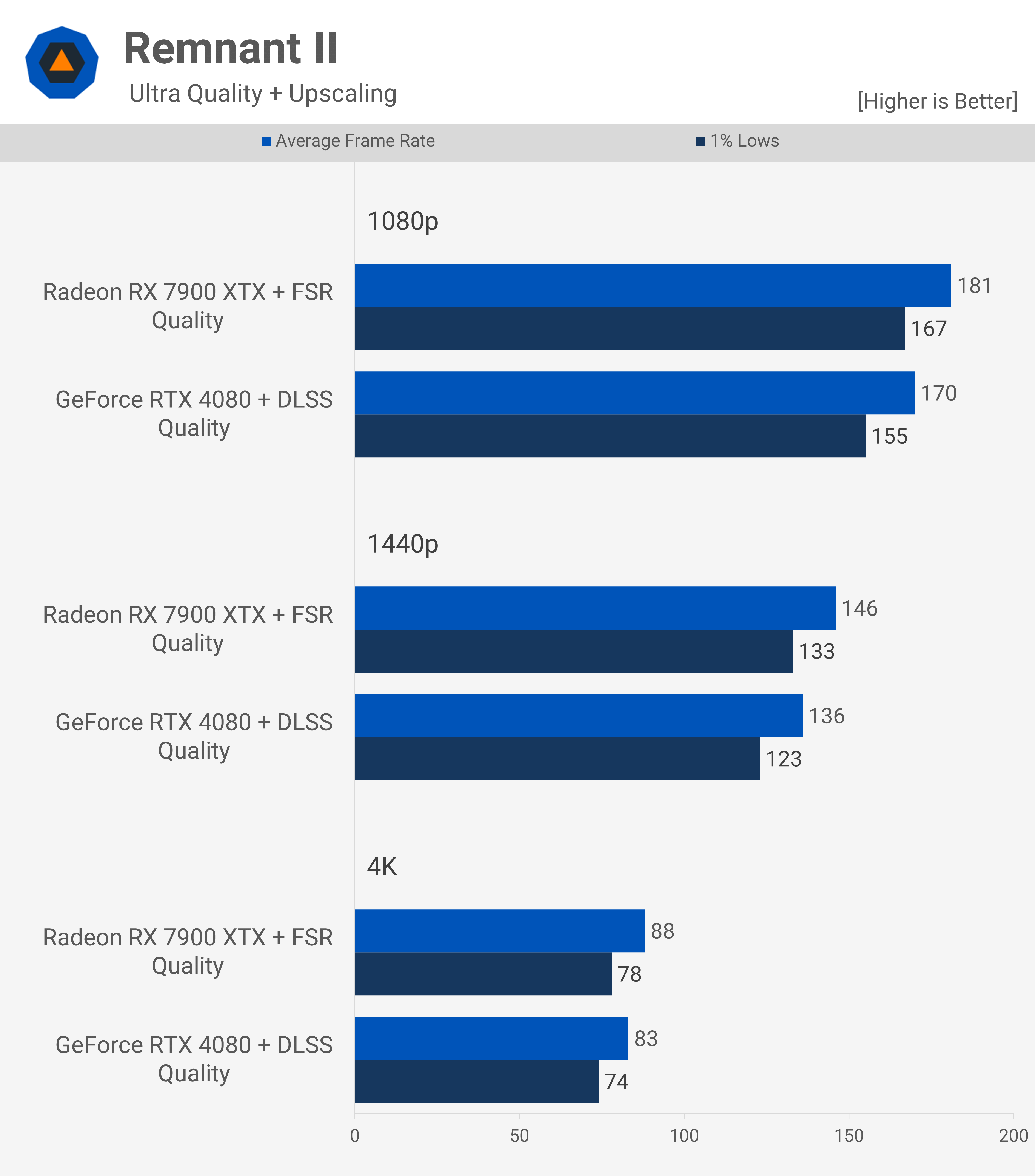
With FSR and DLSS activated, the differences diminish. The 7900 XTX retained its lead, providing a 6% improvement at 1080p, 7% at 1440p, and 6% at 4K. Overall, the gaming experience was very comparable.
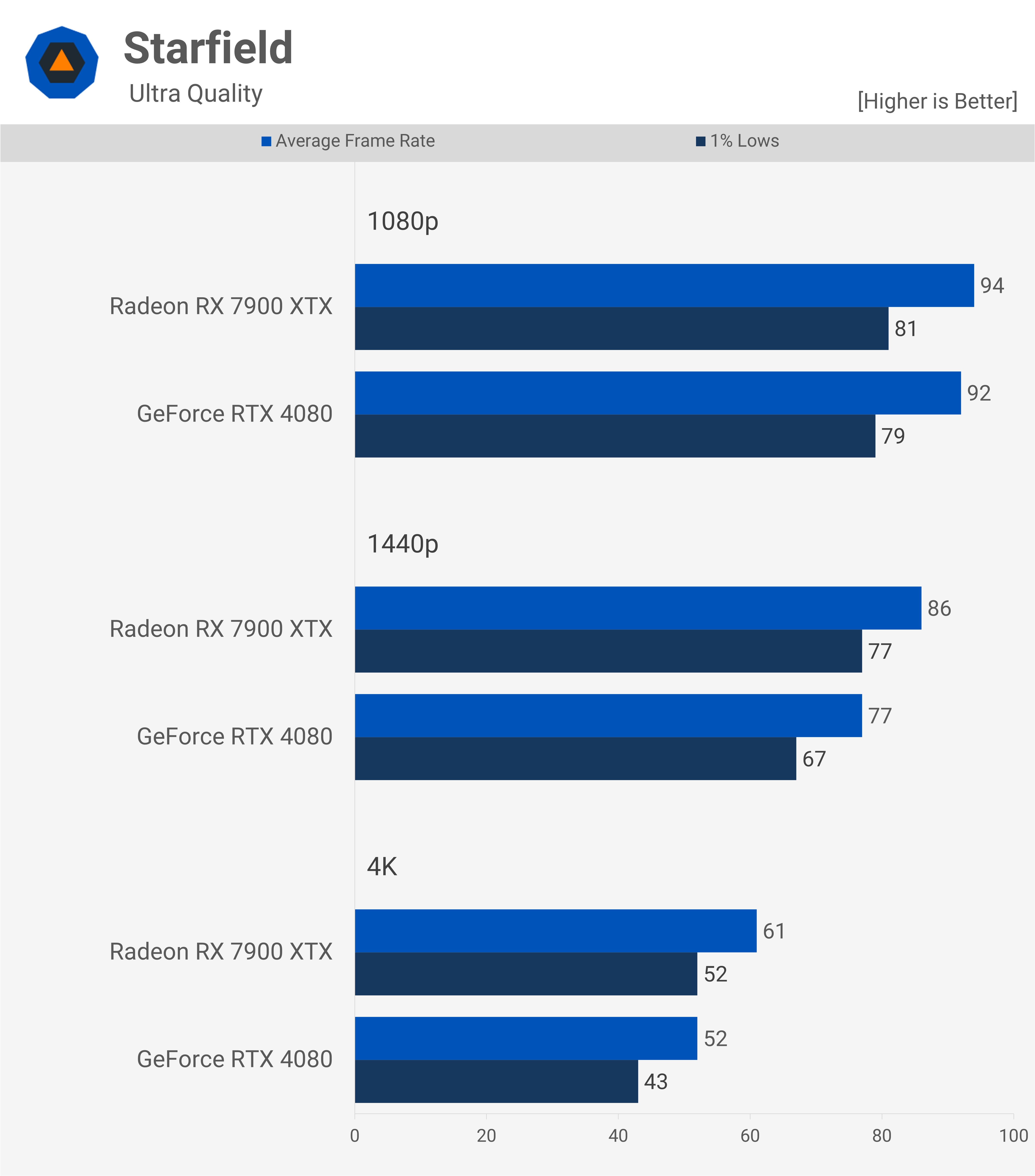
Starfield is up next, and it heavily favors AMD. At 1080p, the results were mostly constrained by the CPU, but at 1440p, the 7900 XTX was 12% ahead, and 17% faster at 4K. This performance allowed the Radeon GPU to maintain over 60 fps on average.
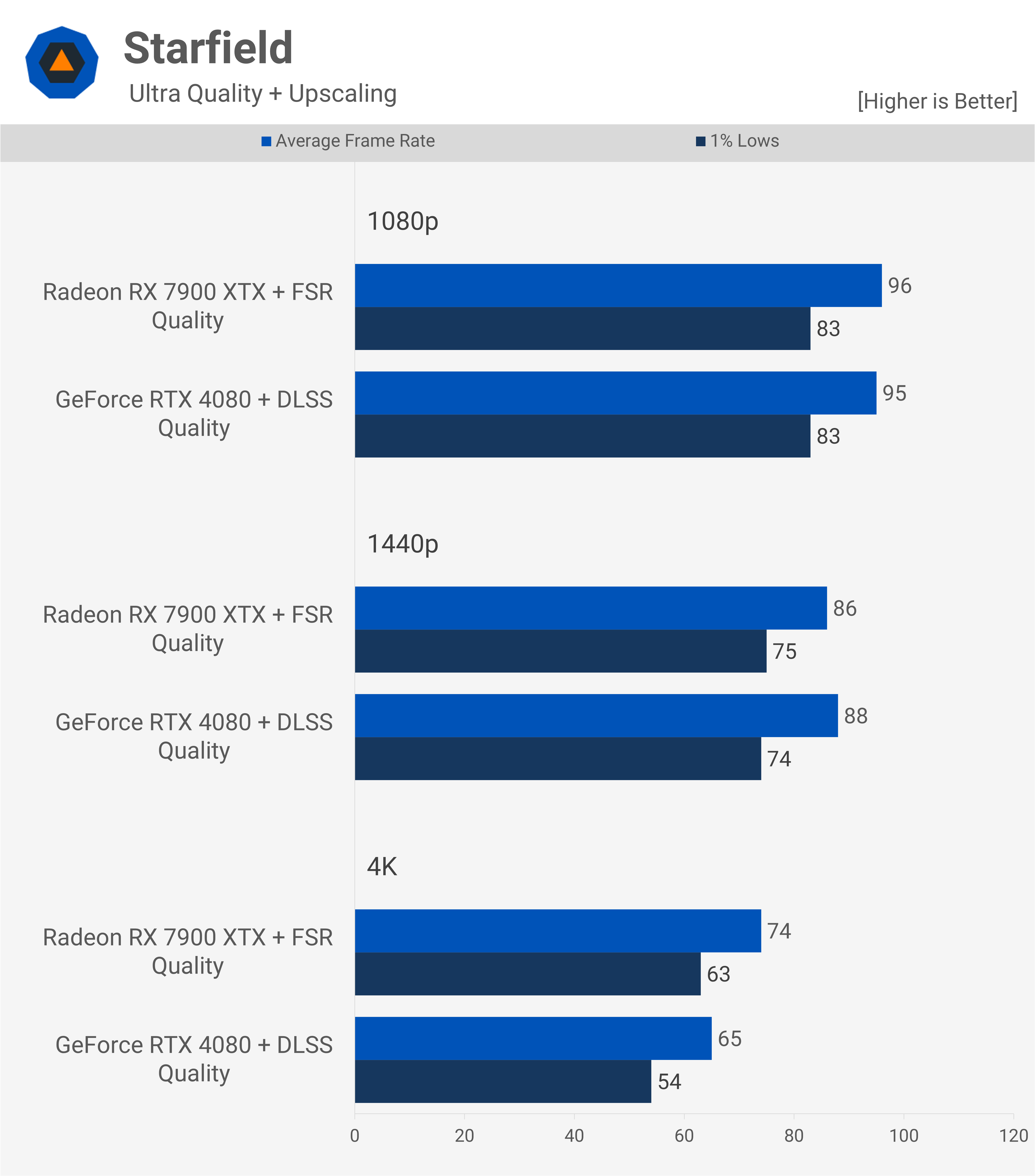
Activating FSR and DLSS for the respective GPUs, there was little difference at 1080p. However, at 1440p, the RTX 4080 began to close the gap. At 4K, the Radeon GPU achieved a 21% boost with FSR, while the RTX 4080 saw a 25% enhancement with DLSS, resulting in the 7900 XTX holding a 14% performance lead.
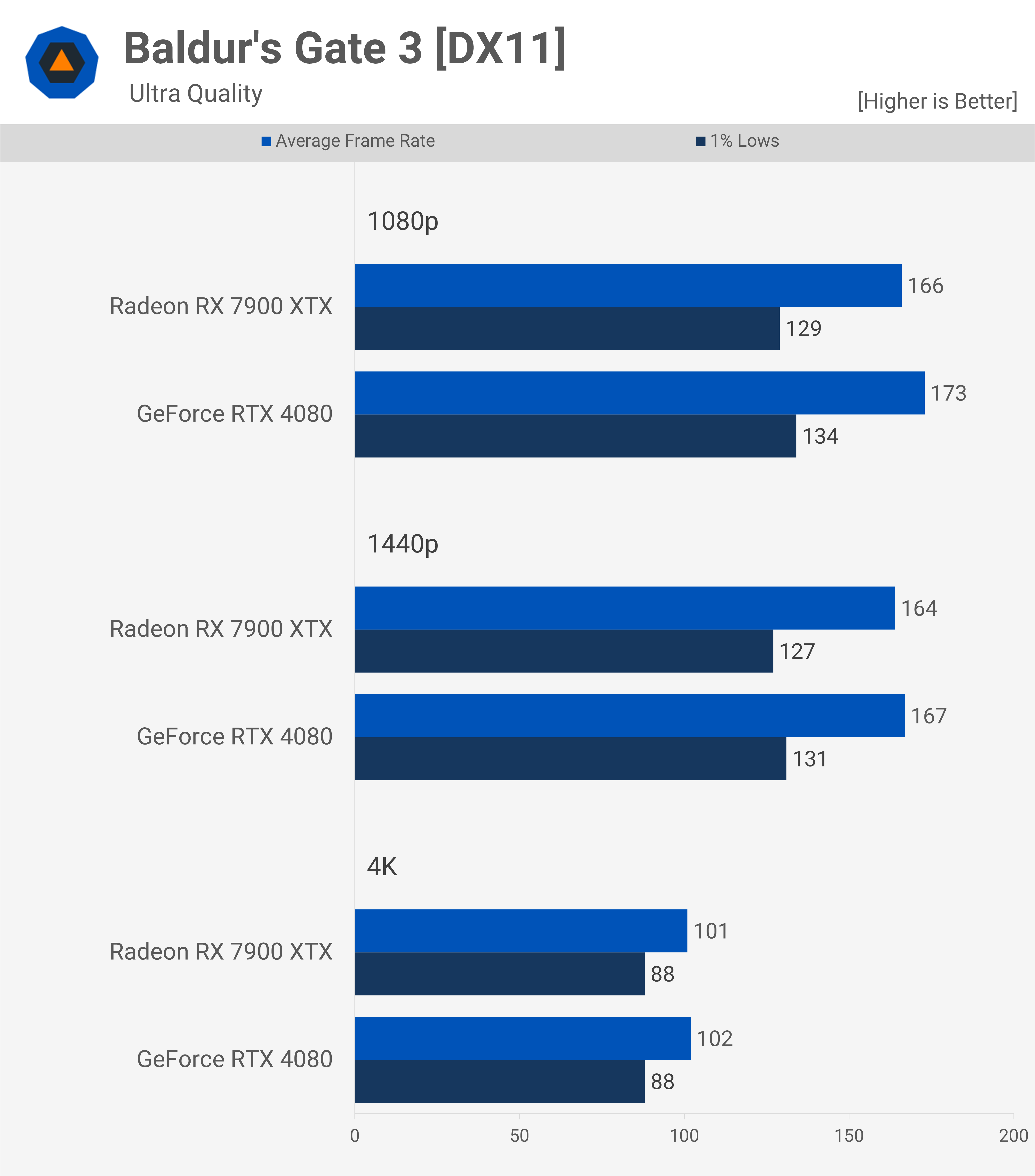
Turning to Baldur’s Gate 3 and utilizing ultra-quality settings, the two GPUs demonstrated nearly identical performance. Results at 1080p and 1440p were CPU-bound, but even at 4K, the performance in the City of Baldur’s Gate was virtually the same.

When upscaling was turned on, performance at 1080p and 1440p remained consistent. However, 4K saw a significant improvement, with the Radeon GPU achieving a remarkable 60% boost, granting it a 9% lead over the RTX 4080.
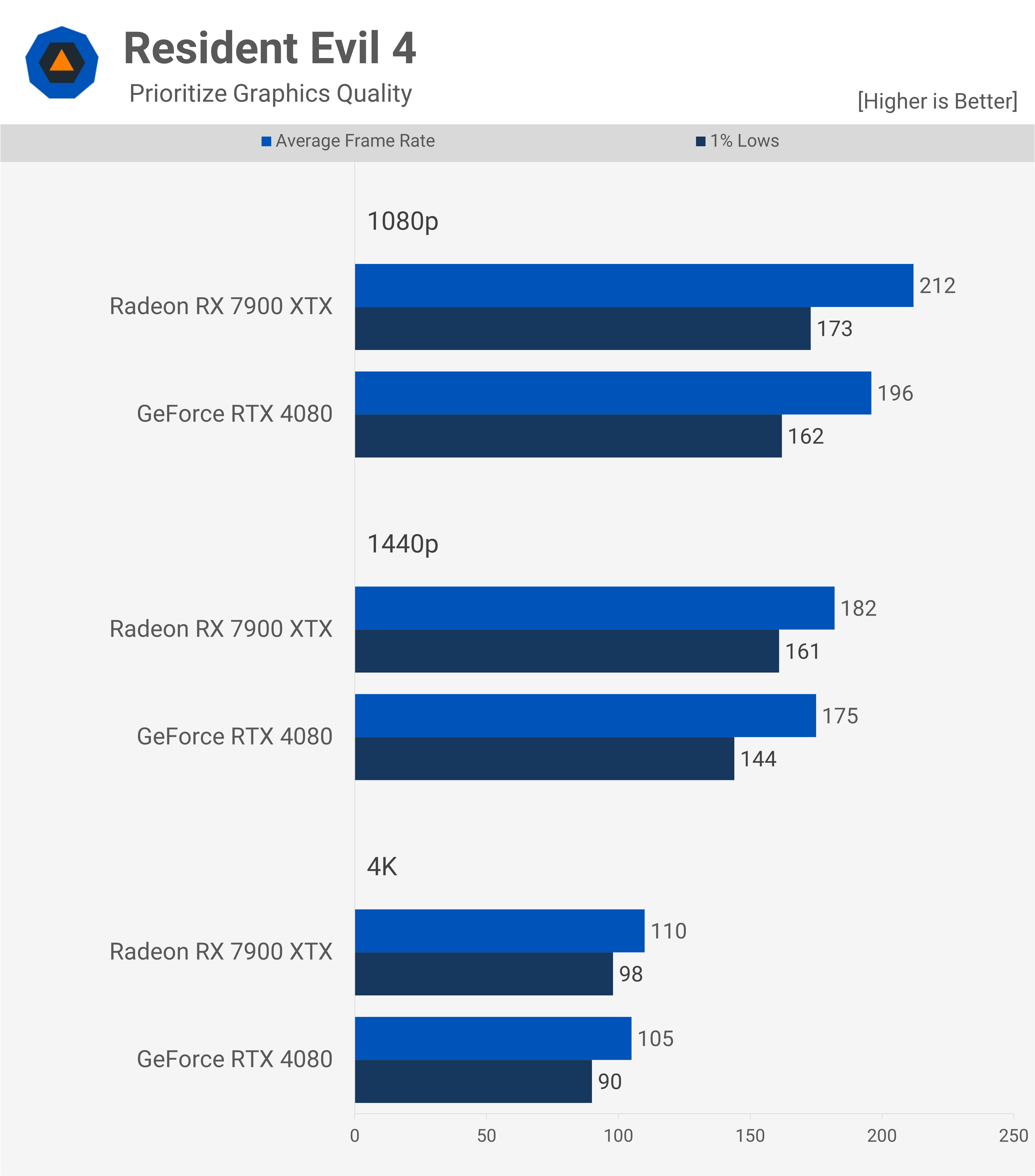
For Resident Evil 4, using the prioritize graphics preset (which omits ray tracing), the 7900 XTX held a slight edge over the 4080 across all tested resolutions. Both GPUs exhibited top-tier performance.

This game only supports FSR. To avoid complications, we activated the maximum quality preset, which incorporates Ray Tracing. The RTX 4080 edged forward at 1080p and 1440p by a 4% lead, while the 7900 XTX was 4% ahead at 4K. The competition was tight overall.
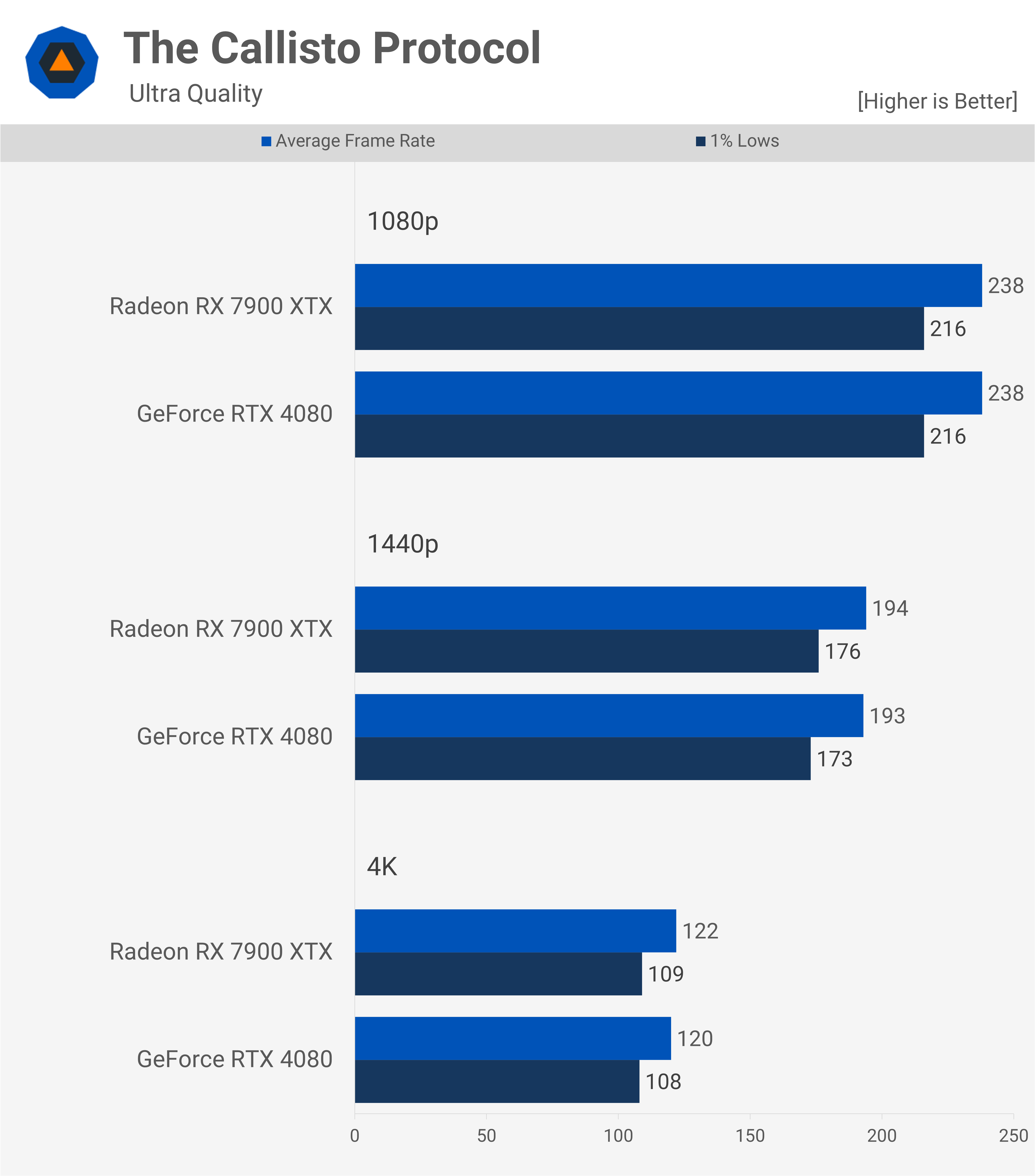
Finally, with The Callisto Protocol, the RTX 4080 and 7900 XTX were almost indistinguishable, offering virtually identical results across all tested resolutions using the ultra-quality preset.
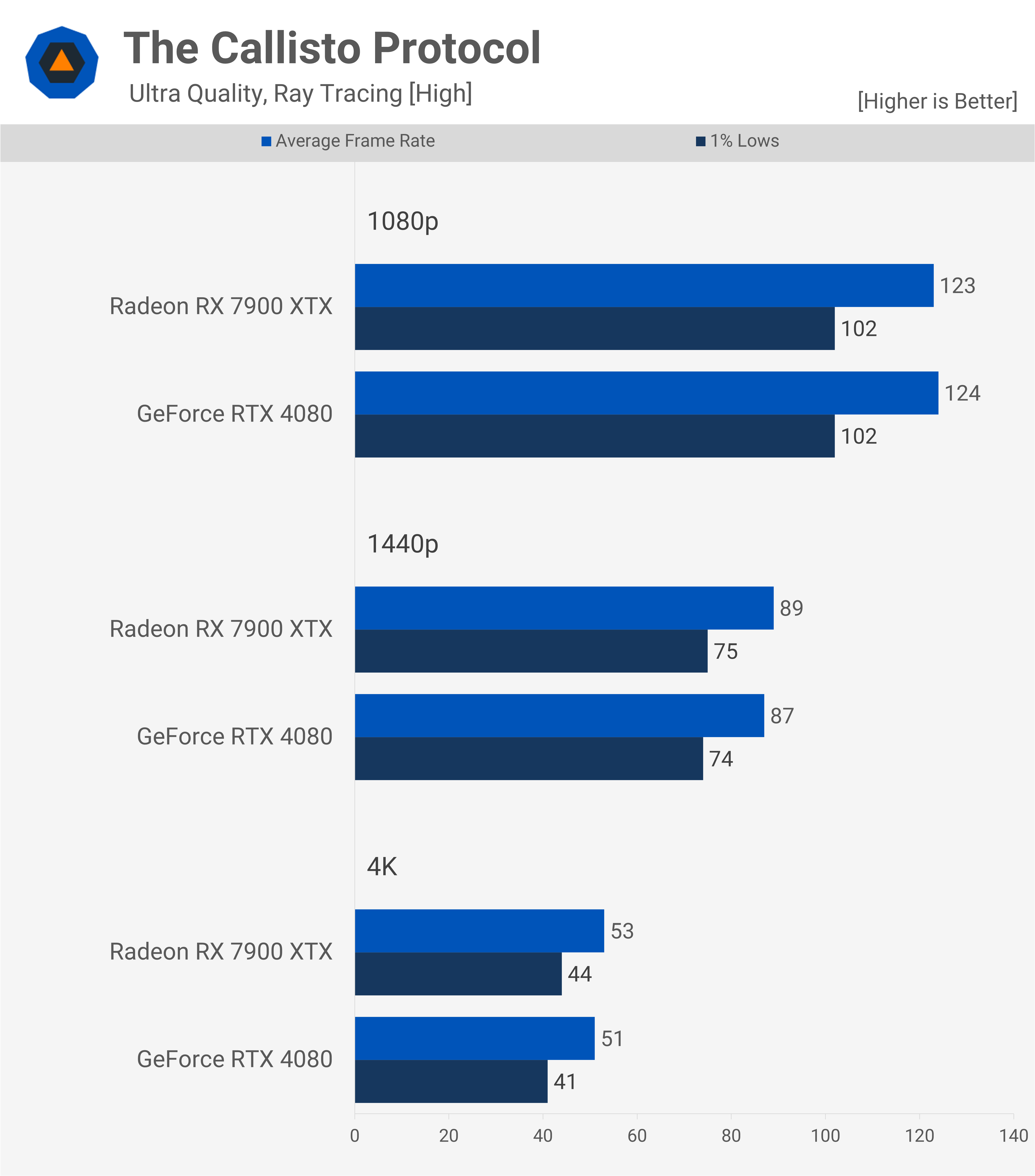
Interestingly, even with ray tracing activated, the same parity persisted. Typically, one would anticipate the RTX 4080 to have a slight advantage, but both GPUs performed closely, even with a significant drop in frame rates.
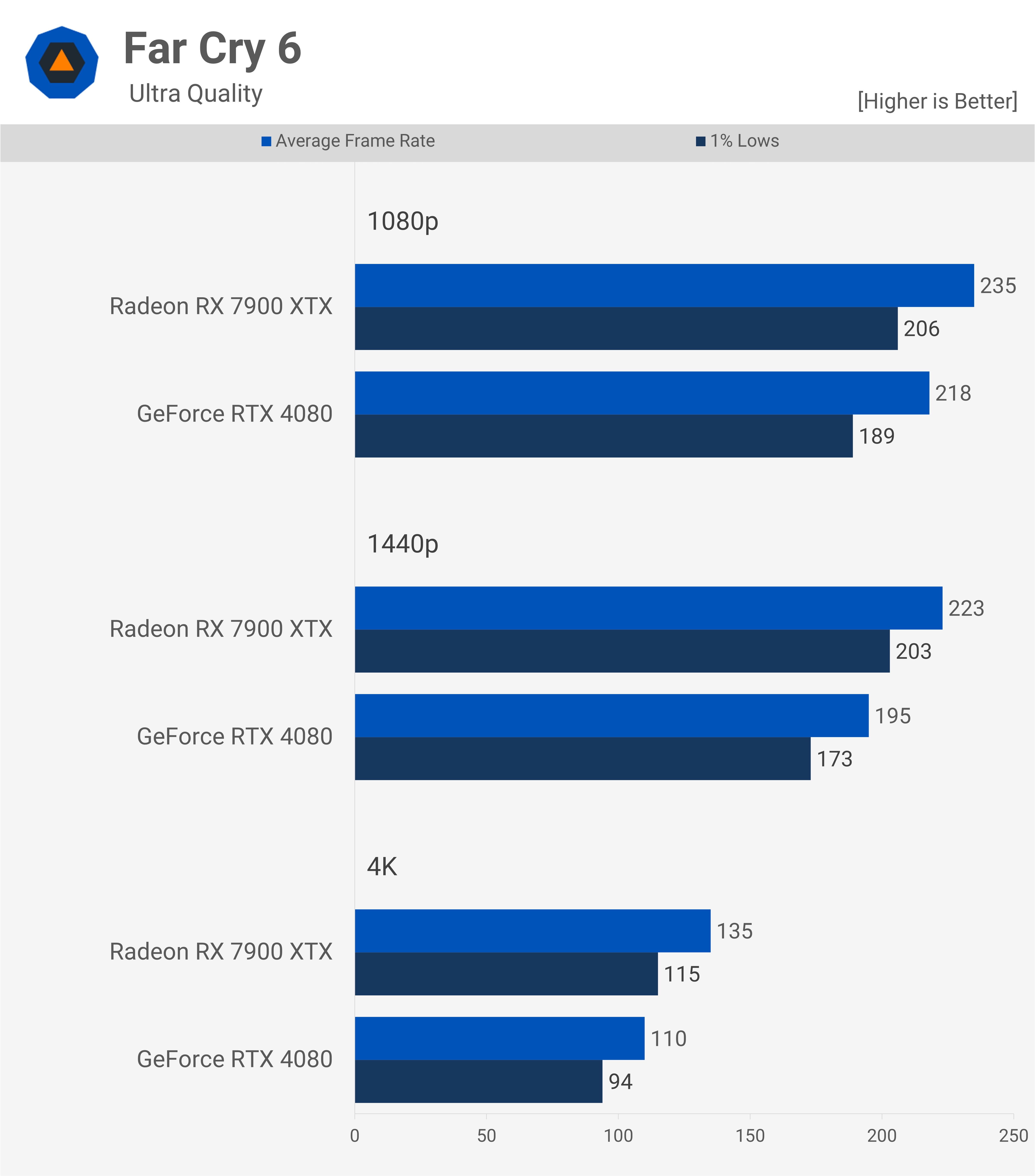
Turning to Far Cry 6, this game supports only FSR. Therefore, we’ll examine the native rasterized performance along with additional ray tracing metrics. Using the ultra preset, the 7900 XTX outpaces the competition by 8% at 1080p, 14% at 1440p, and a remarkable 23% at 4K.
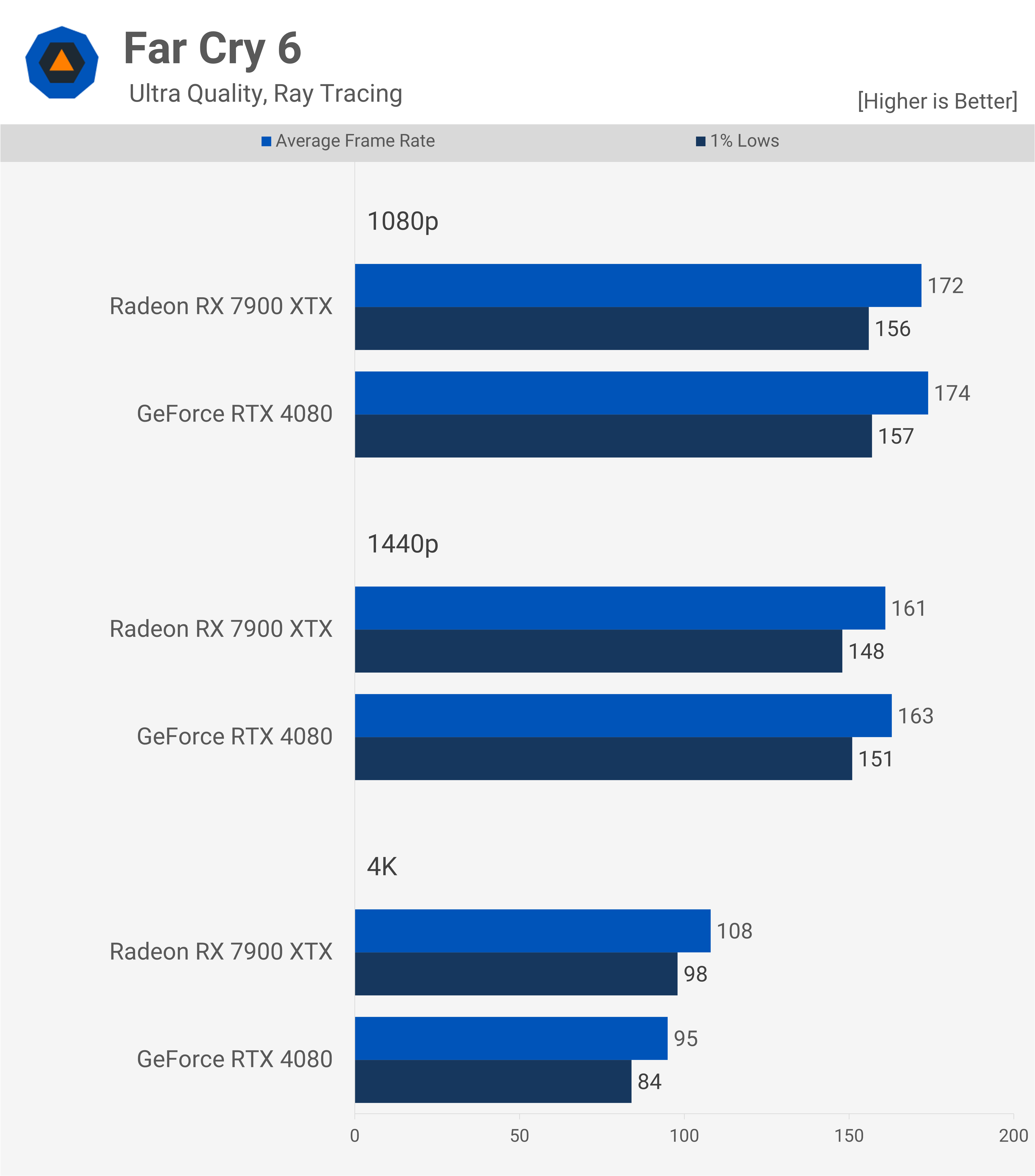
When ray tracing is activated, the performance at 1080p and 1440p caps at just above 160 fps due to CPU limitations. However, at 4K, the Radeon GPU retains its lead, generating 14% more frames with an average of 108 fps.
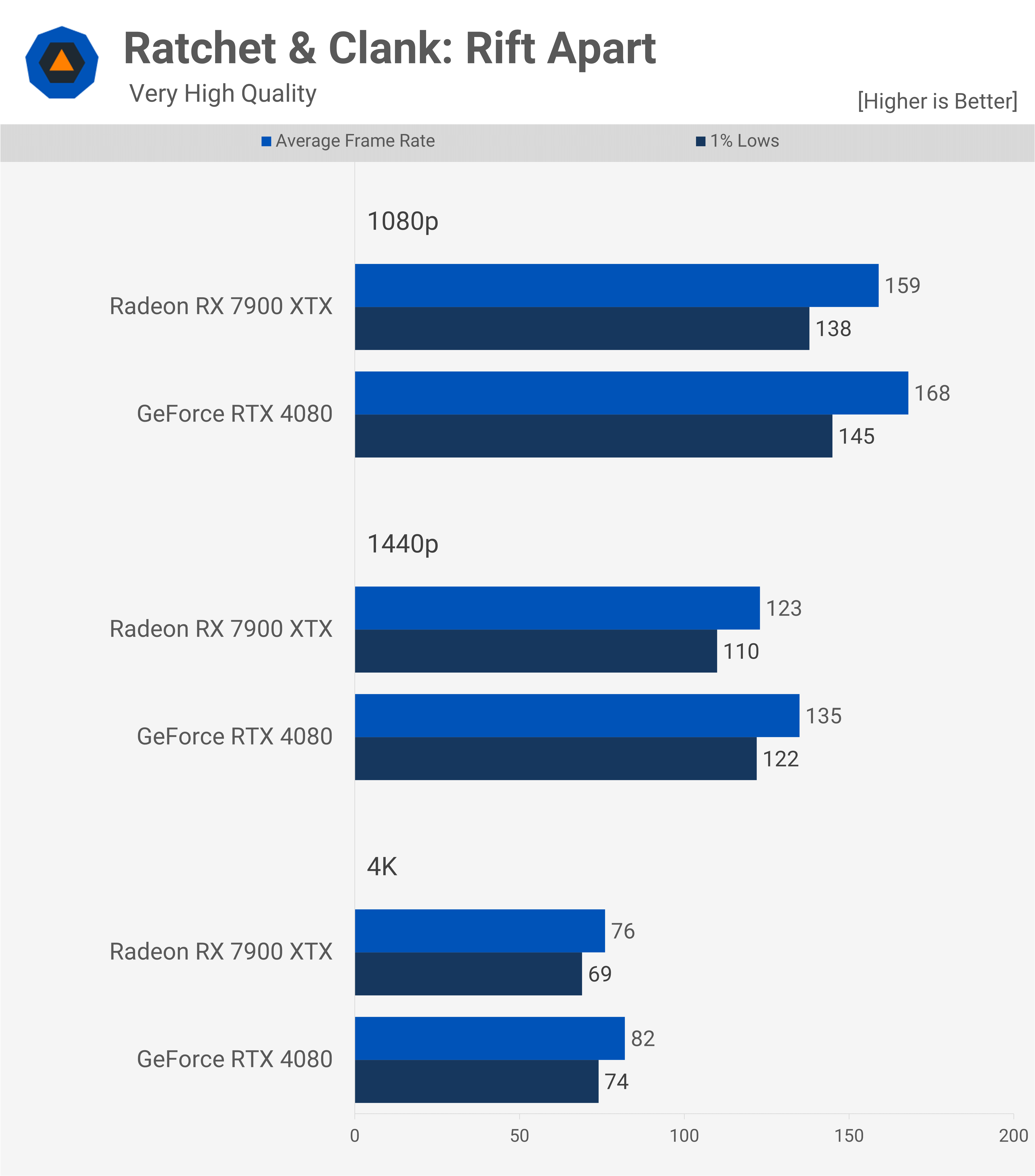
Ratchet & Clank: Rift Apart has been evaluated under various configurations. Starting with the very high preset, the RTX 4080 surpasses its competitor by 6% at 1080p, 10% at 1440p, and 8% at 4K. Clearly, the GeForce GPU has the upper hand, although the difference isn’t always substantial.
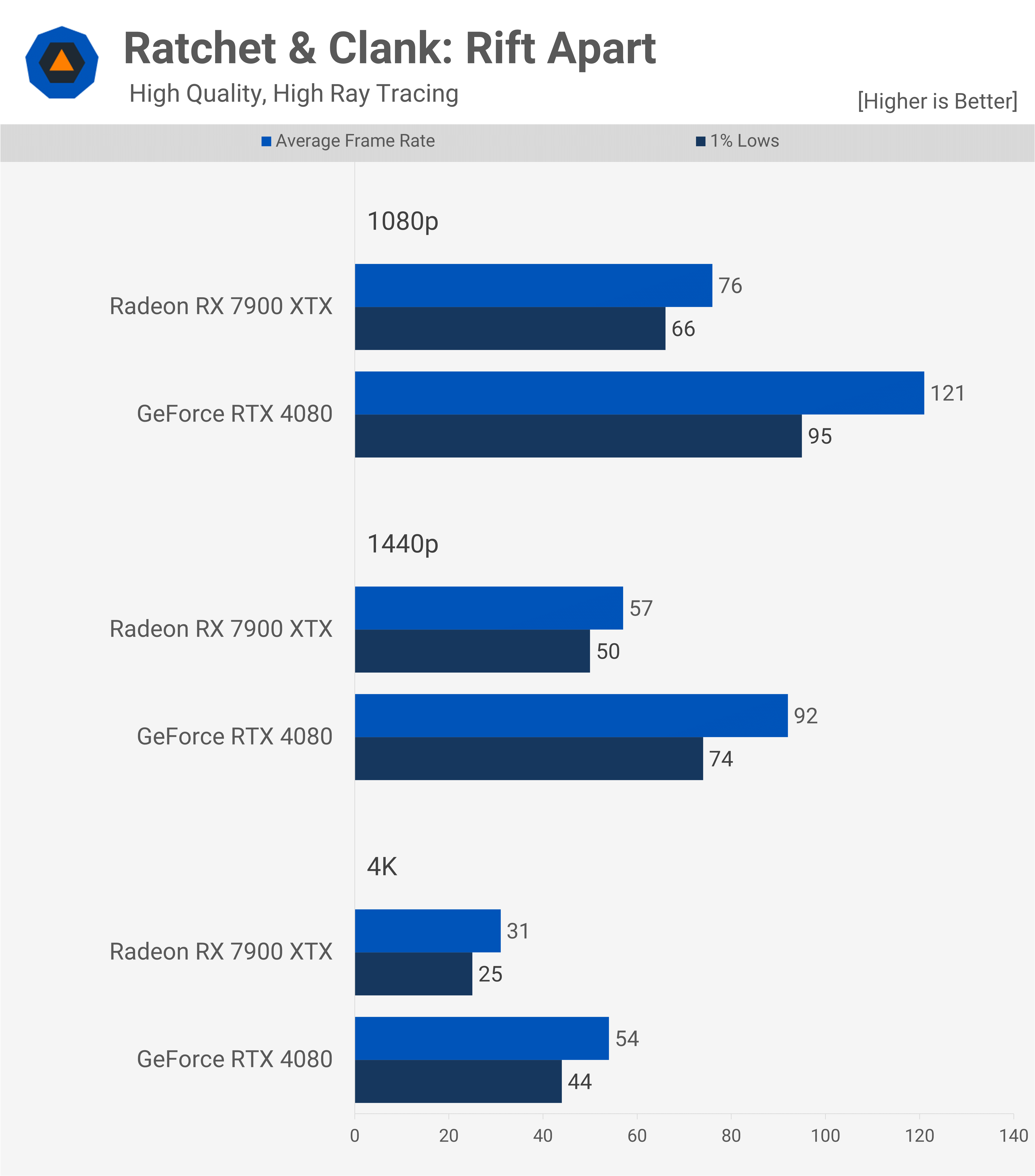
However, when ray tracing is activated using the high-quality settings, the 7900 XTX lags significantly, producing only 76 fps at 1080p, which puts the 4080 ahead by an astonishing 59%. This trend continues with the 4080 being 61% and 74% faster at 1440p and 4K, respectively.
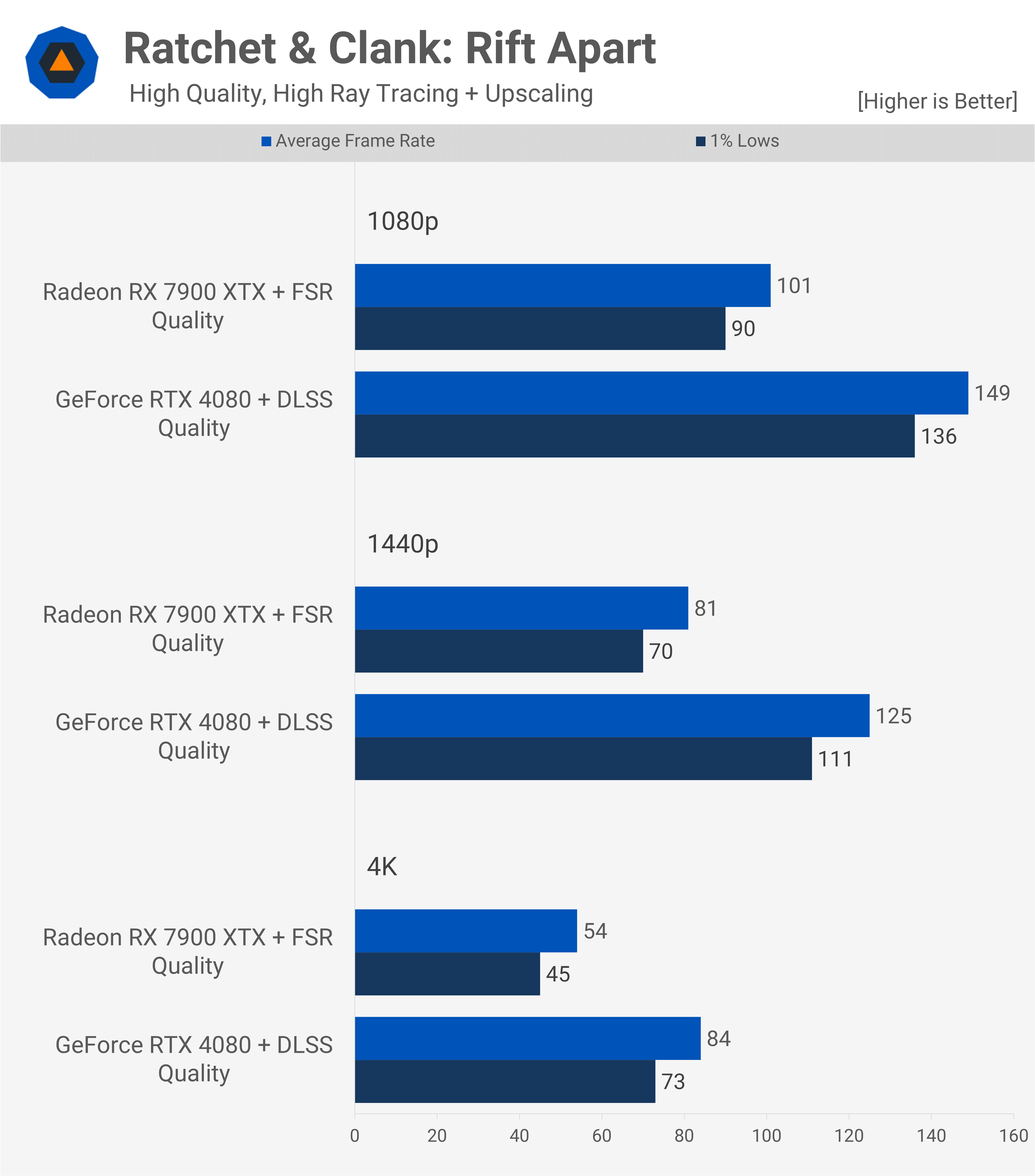
Introducing upscaling, the RTX 4080 outperforms by delivering 48% more frames at 1080p, 54% at 1440p, and 56% at 4K. Notably, at 4K, the RTX 4080 ensures an engaging gaming experience with 84 fps, leaving the 7900 XTX trailing with an average of 54 fps.
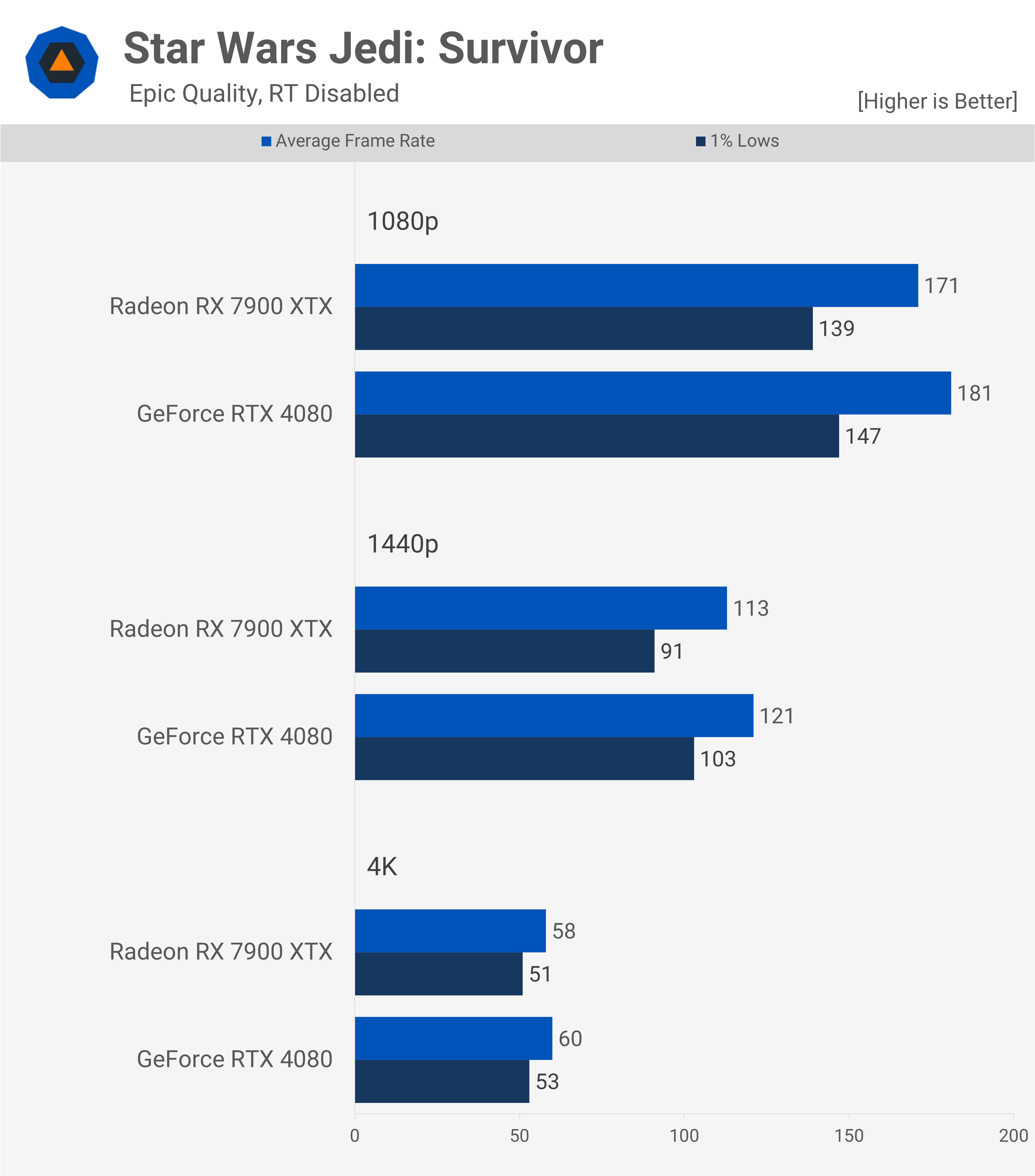
Next, we delved into Star Wars Jedi: Survivor. Using the Epic preset (ray tracing off), the GeForce GPU led by 6% at 1080p, 7% at 1440p, and a modest 3% at 4K.
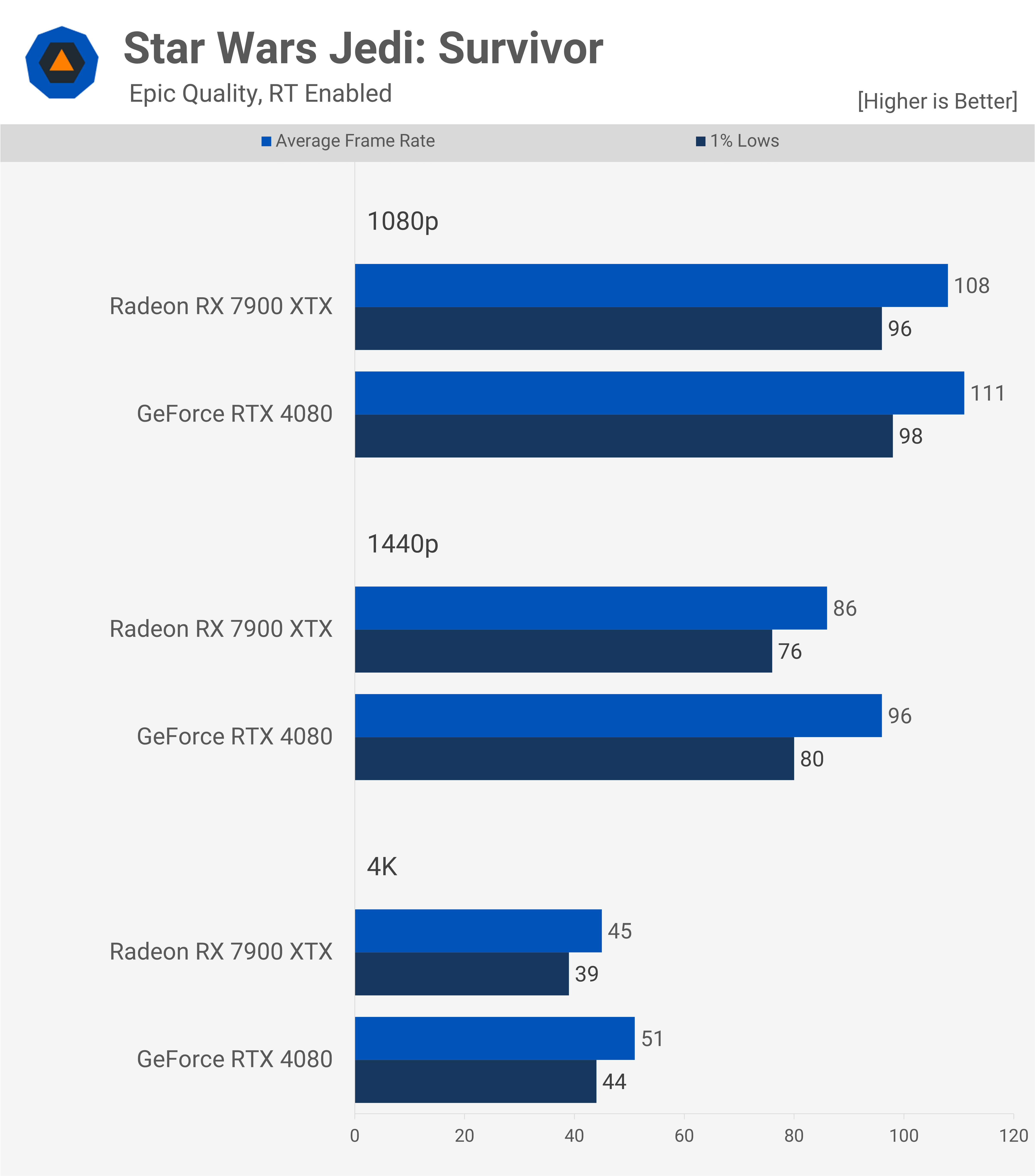
Upon enabling ray tracing, the RTX 4080’s advantage was merely 3% at 1080p. Although these results are CPU-constrained, the GeForce GPU’s lead grew to 12% at 1440p and 13% at 4K. Enabling ray tracing has given a slight edge to the GeForce GPU.
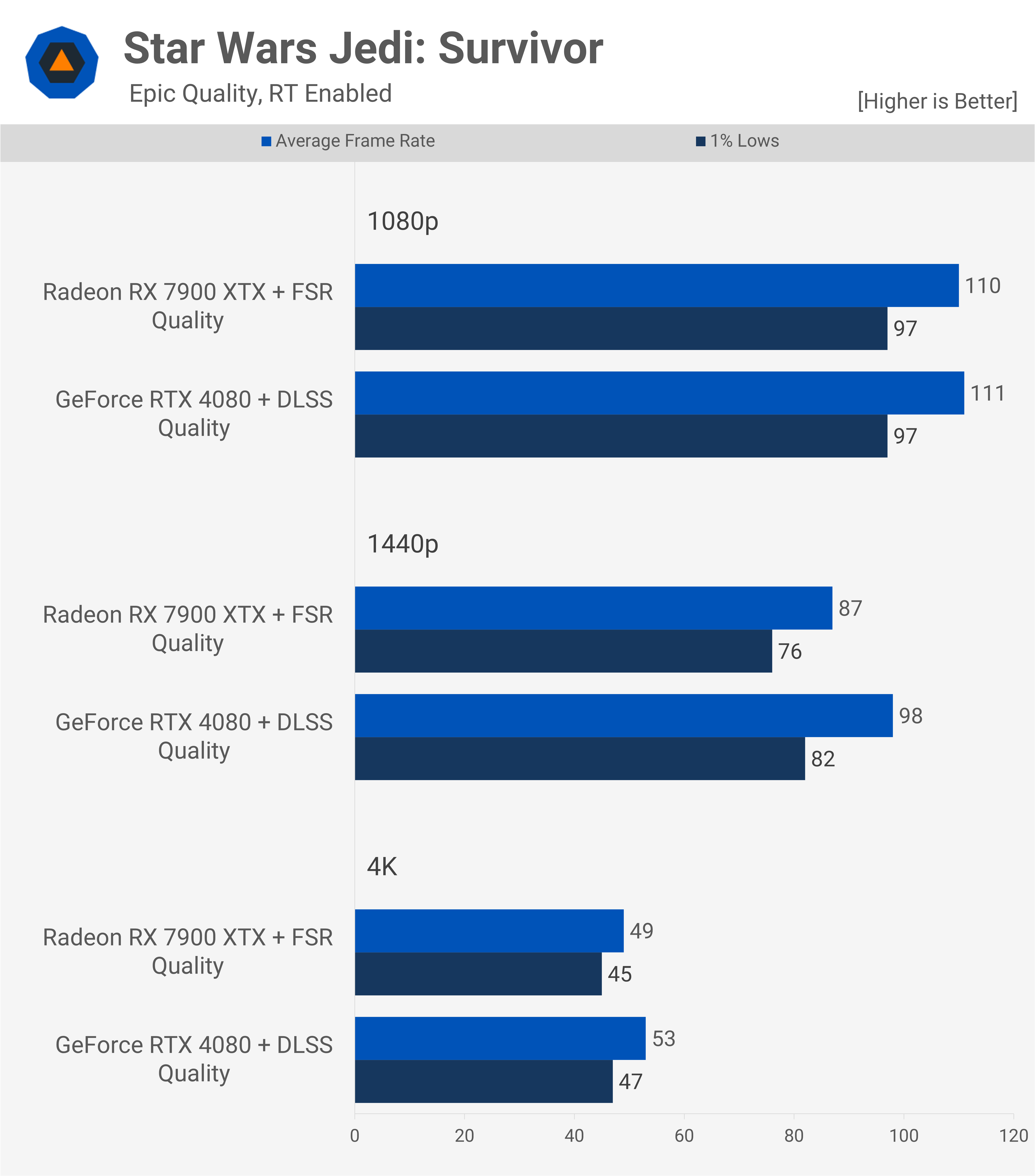
However, with upscaling turned on, we encountered CPU limitations at 1080p with an average of around 110 fps. Upping the resolution to 1440p eased the CPU bottleneck, awarding the RTX 4080 a 13% lead, which aligns with the previous findings, and then 8% at 4K.
Unfortunately, upscaling seems to malfunction in Star Wars Jedi: Survivor. Despite thorough validation of our results, it seems neither FSR nor DLSS offers substantial performance enhancements in this game.

Though Hitman 3 is an older title, it integrates both ray tracing and DLSS/FSR, warranting its inclusion. With the ultra preset, the 7900 XTX and RTX 4080 are neck and neck at 1080p and 1440p. However, at 4K, the Radeon GPU pulls ahead, boasting a 17% performance lead.
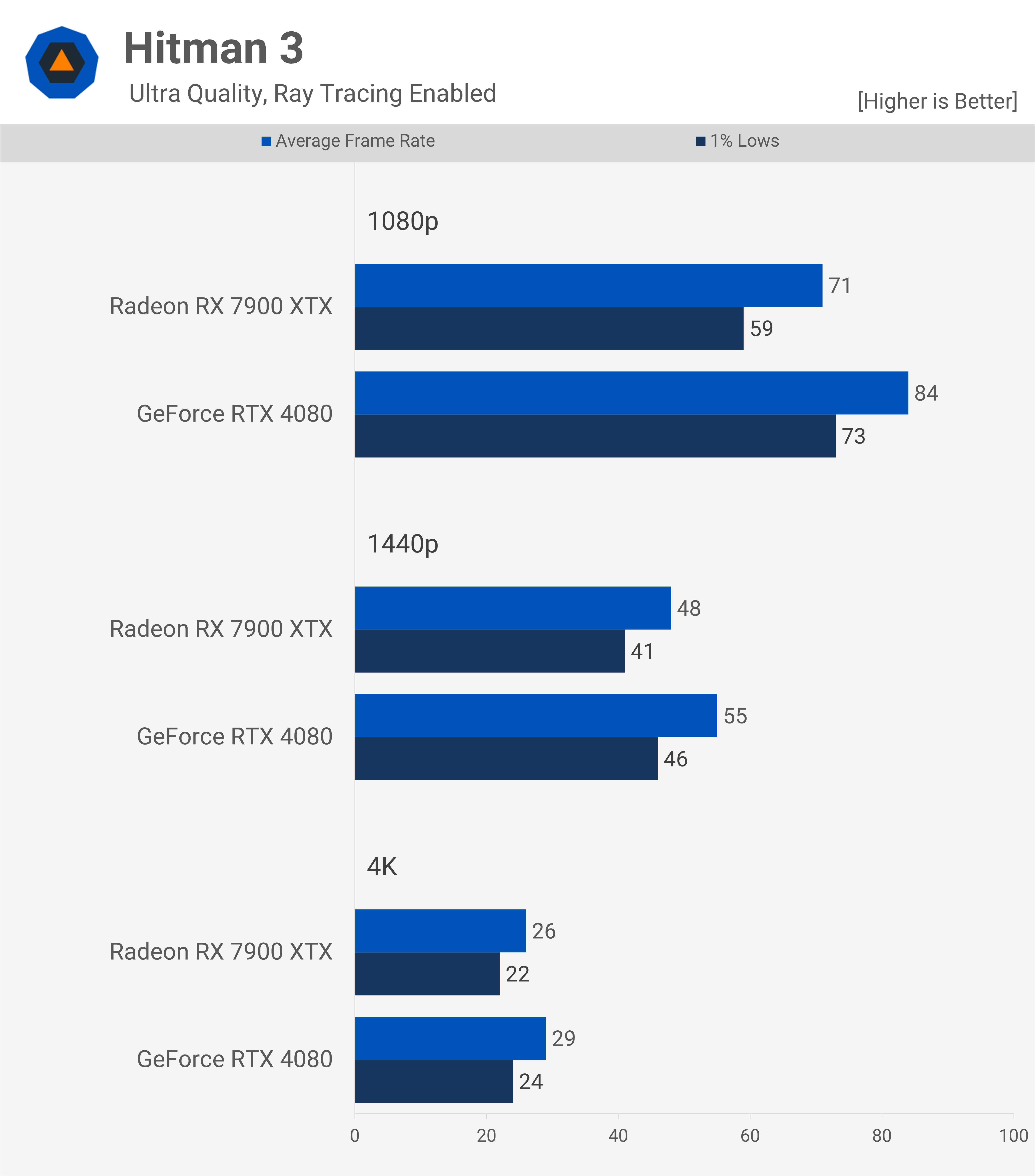
Introducing ray tracing changes the dynamics, putting the 4080 in the lead by 18% at 1080p, 15% at 1440p, and 12% at 4K. Frame rates dipped substantially with ray tracing, prompting us to explore upscaling.
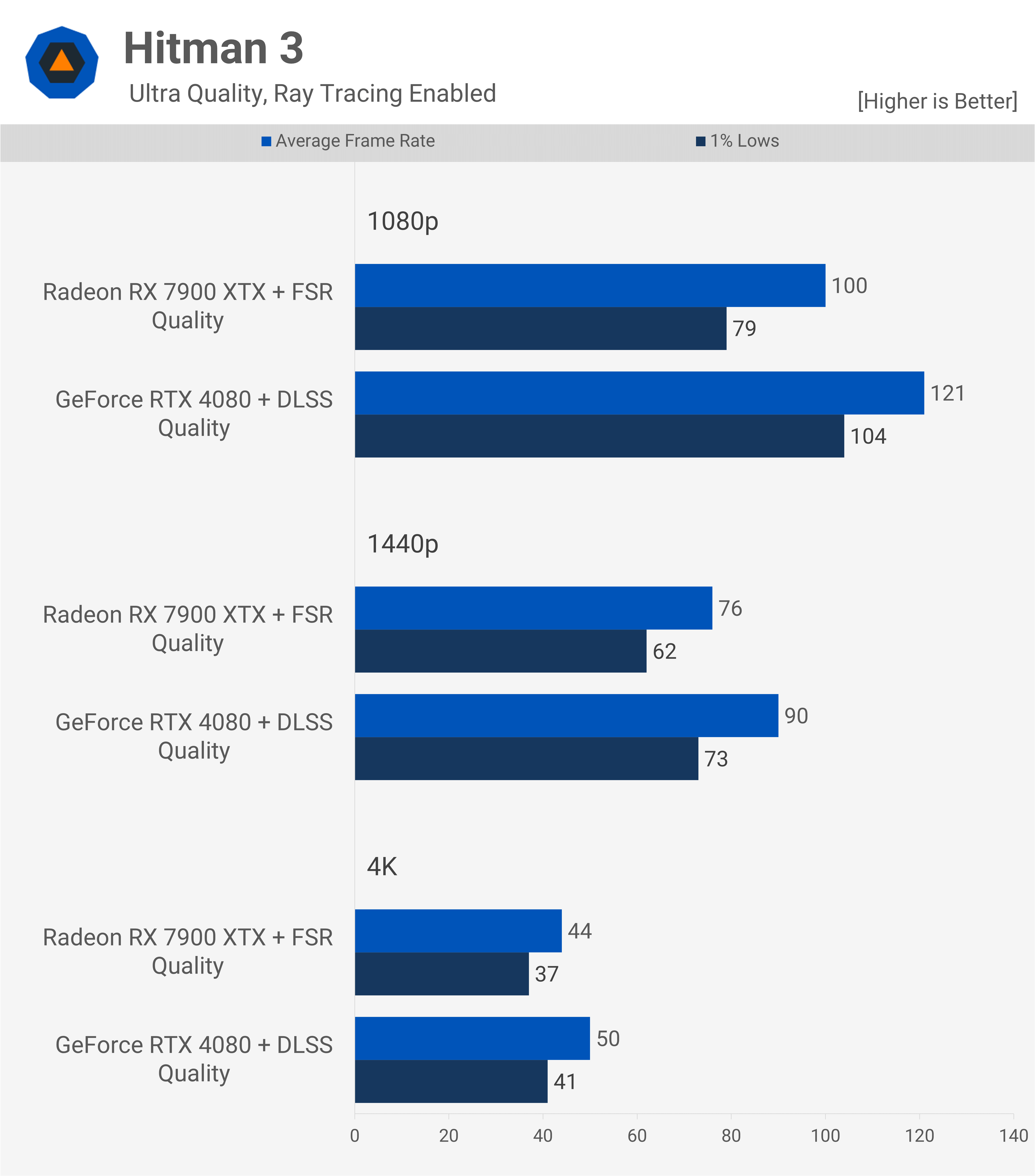
Here, both FSR and DLSS notably enhance performance. The GeForce GPU establishes a dominant lead: 21% at 1080p (though the 7900 XTX achieves a respectable 100 fps), 18% at 1440p, and 14% at 4K.

Shifting to F1 23, we first engaged the high-quality preset, the maximum setting without ray tracing. In this scenario, the 7900 XTX substantially outperforms the RTX 4080, with advantages of 26% at 1080p, 24% at 1440p, and 21% at 4K.
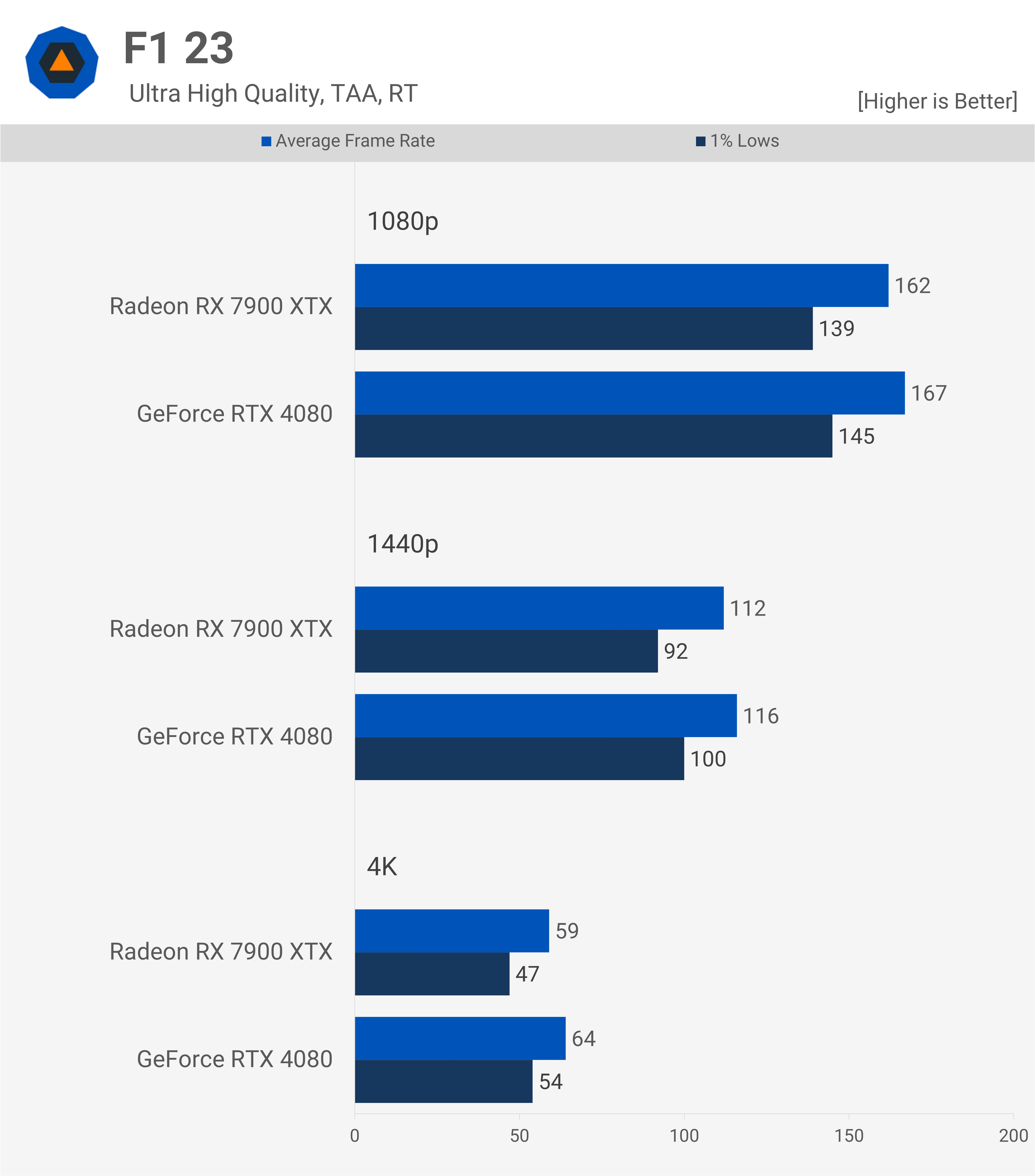
However, upon activating the ultra-high preset, the tables turn, allowing the RTX 4080 to edge ahead – 3% at 1080p, 4% at 1440p, and 8% at 4K.
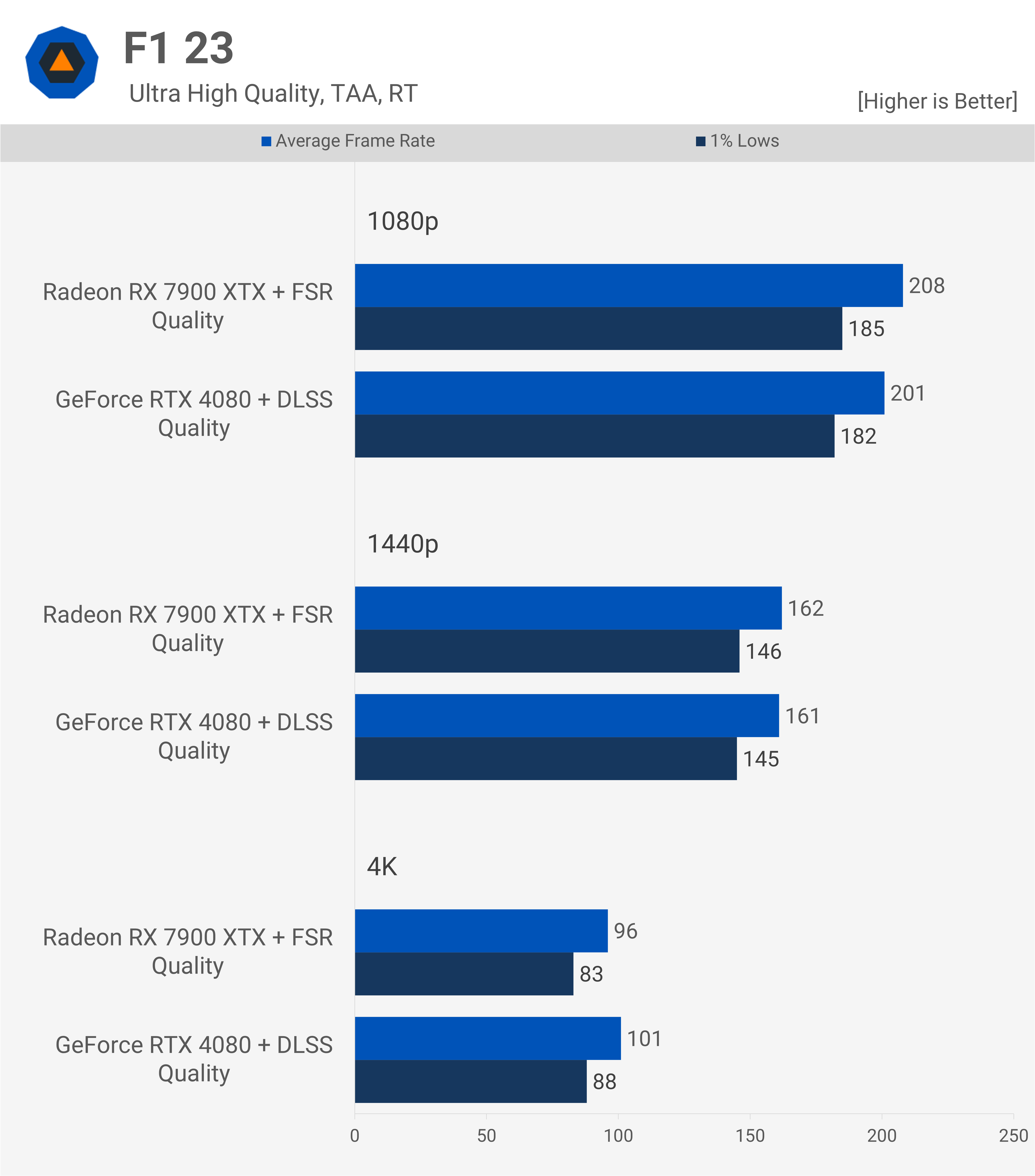
With upscaling, we noticed a remarkable surge in performance. The 7900 XTX and RTX 4080 are closely matched, with a mere 5% discrepancy at most.
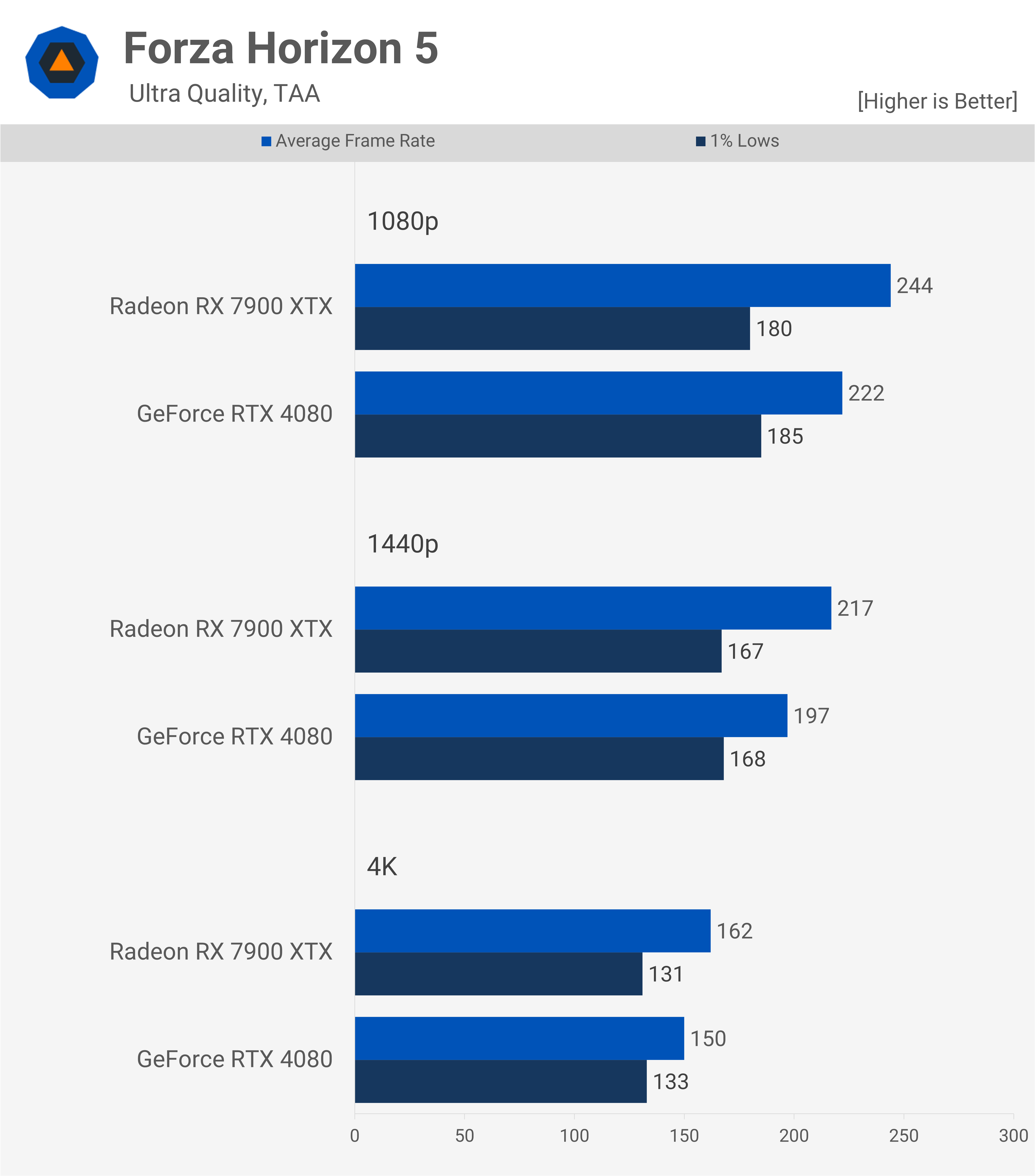
Delving into Forza Horizon 5, RDNA 3 GPUs, such as the 7900 XTX, experienced initial performance hiccups, but these appear largely resolved. While the 1% lows didn’t match up to the 4080’s, the overall performance was commendable with slightly higher average frame rates using the ultra quality preset.

Upon activating ray tracing with the extreme preset, the 7900 XTX generally outperformed its counterpart. However, the 1% lows were comparable to the RTX 4080. Specifically, at 1080p, the Radeon GPU averaged 15% faster, 16% at 1440p, and 20% at 4K.
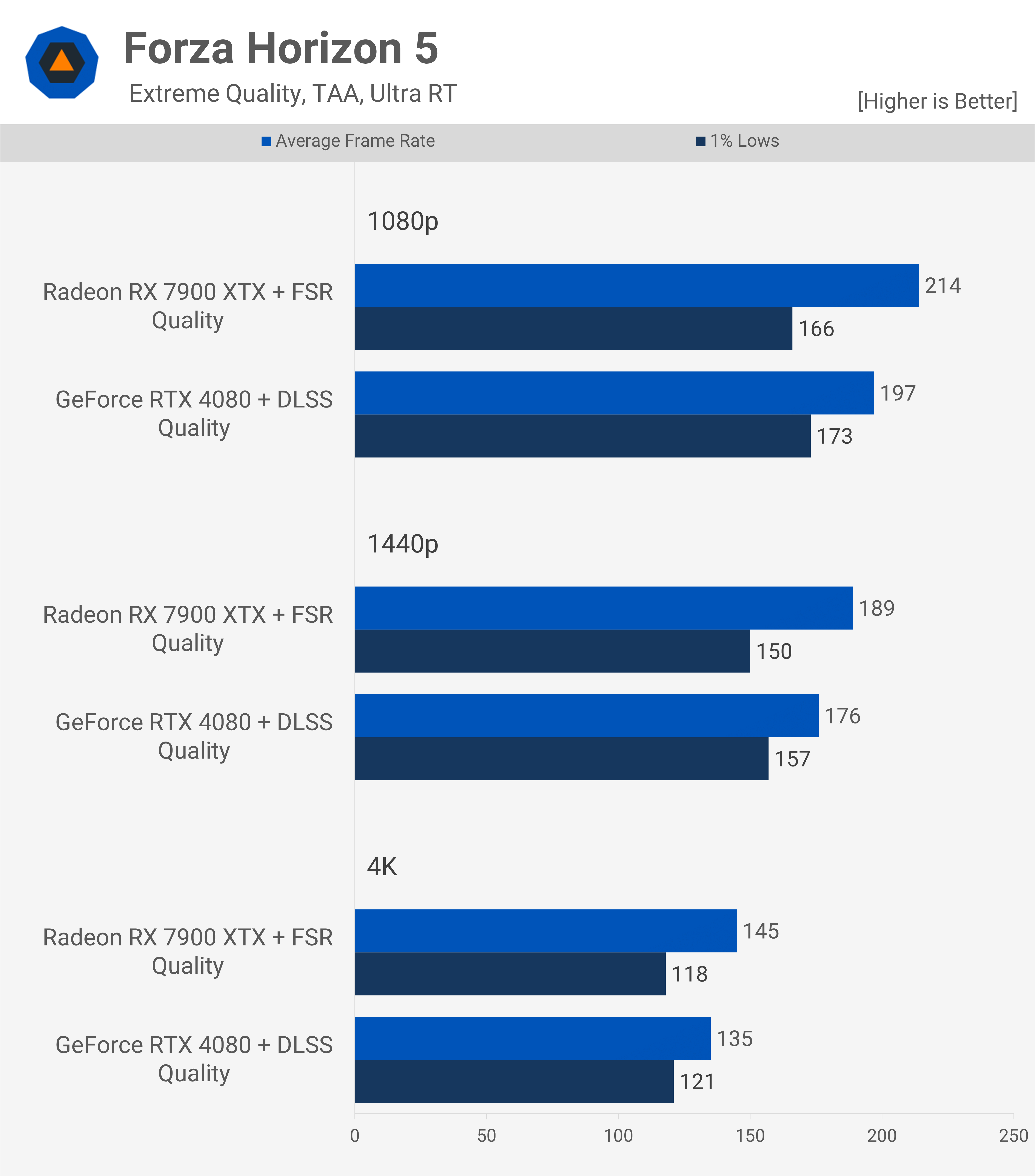
Introducing upscaling, the 7900 XTX showed minimal performance gain, occasionally even dropping a few frames. Contrastingly, the 4080 garnered 4% at 1080p with DLSS, 6% at 1440p, and 11% at 4K. In the 4K scenario, the 7900 XTX’s lead shrank from 20% to a mere 7% once upscaling was enabled.

We evaluated Cyberpunk 2077’s latest version. With the high-quality preset, the 7900 XTX and RTX 4080 ran neck and neck. The Radeon GPU had slight leads of 5% at 1440p and 10% at 4K.

Turning on Ray Tracing significantly impacted the 7900 XTX’s performance. At 1080p, it managed 61 fps, making the GeForce GPU 46% faster. This gap persisted at 1440p (40% faster) and 4K (42% faster). However, neither GPU produced playable frame rates at these settings.
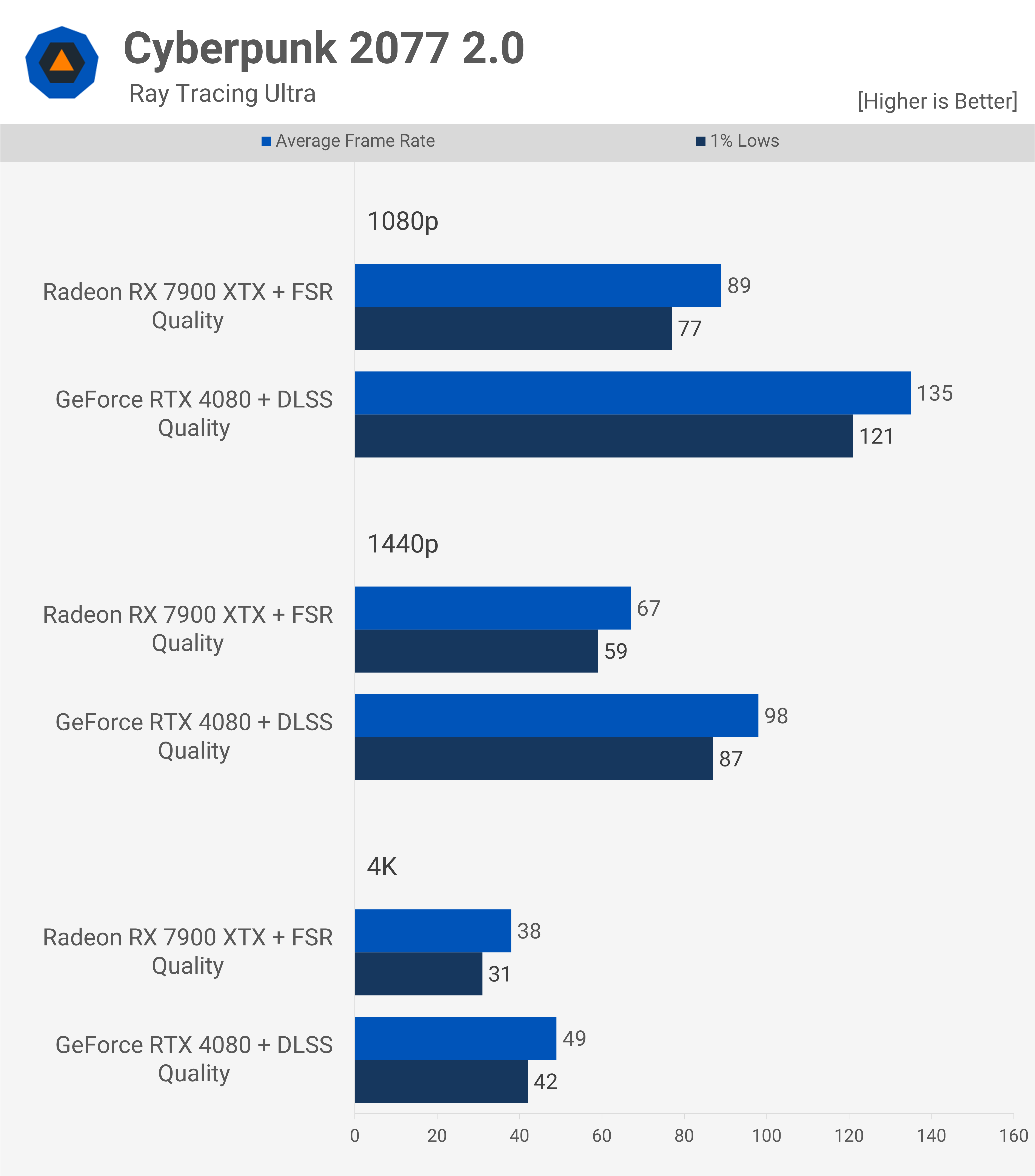
Fortunately, FSR functioned well in this title, and so did DLSS. While the 7900 XTX managed 89 fps at 1080p, the RTX 4080 was still 52% faster. Similar patterns were observed at 1440p (46% faster) and 4K (29% faster), marking a decisive victory for the GeForce GPU.

We then tested Spider-Man Remastered. With the very high preset, performance was CPU-bound at both 1080p and 1440p using the 7800X3D, capping at a remarkable 220 fps. At 4K, both the 7900 XTX and RTX 4080 performed similarly.
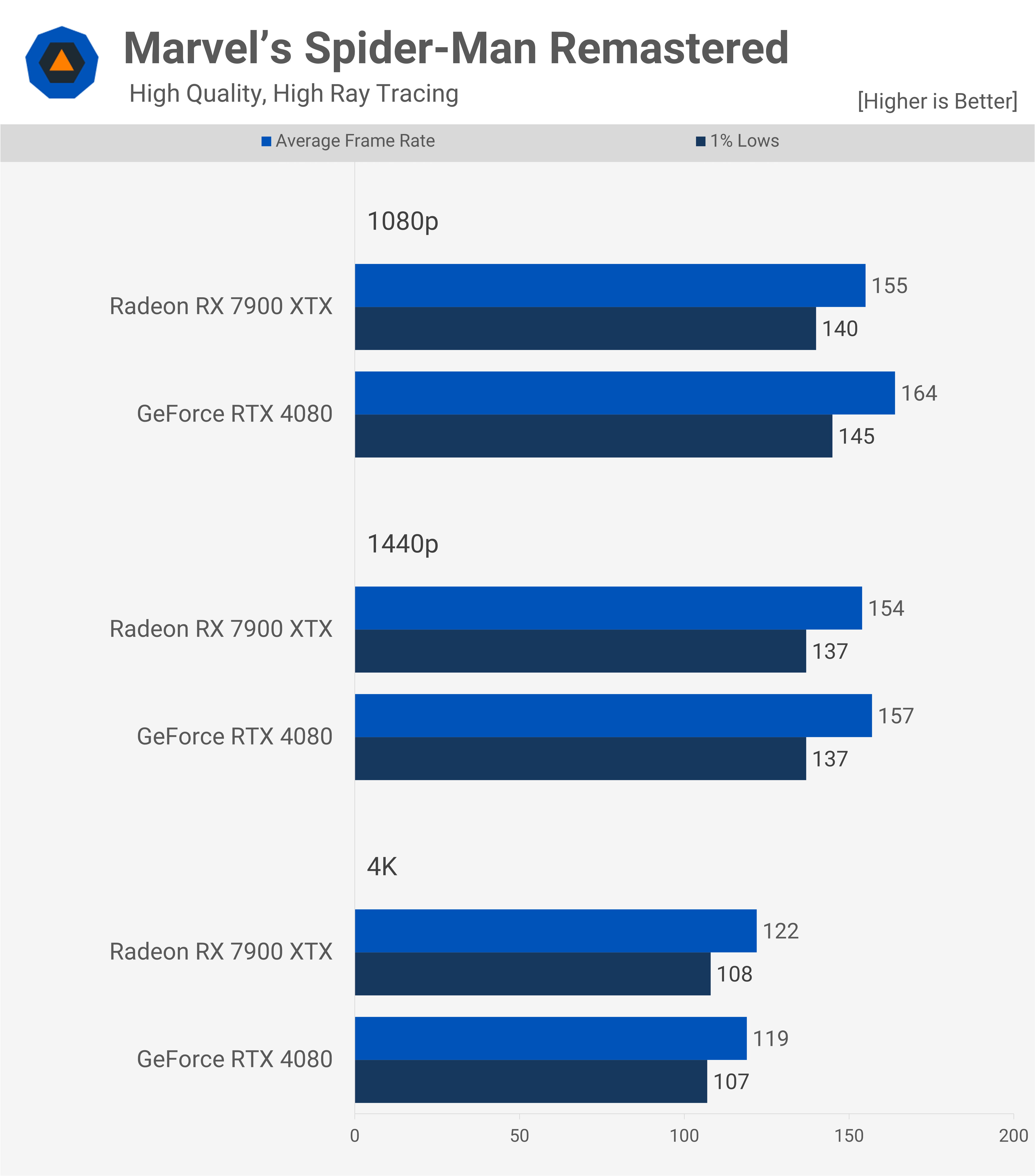
Upon enabling ray tracing, performance dipped, but the GPUs remained closely matched, indicating ray tracing didn’t hamper the Radeon GPU’s output.
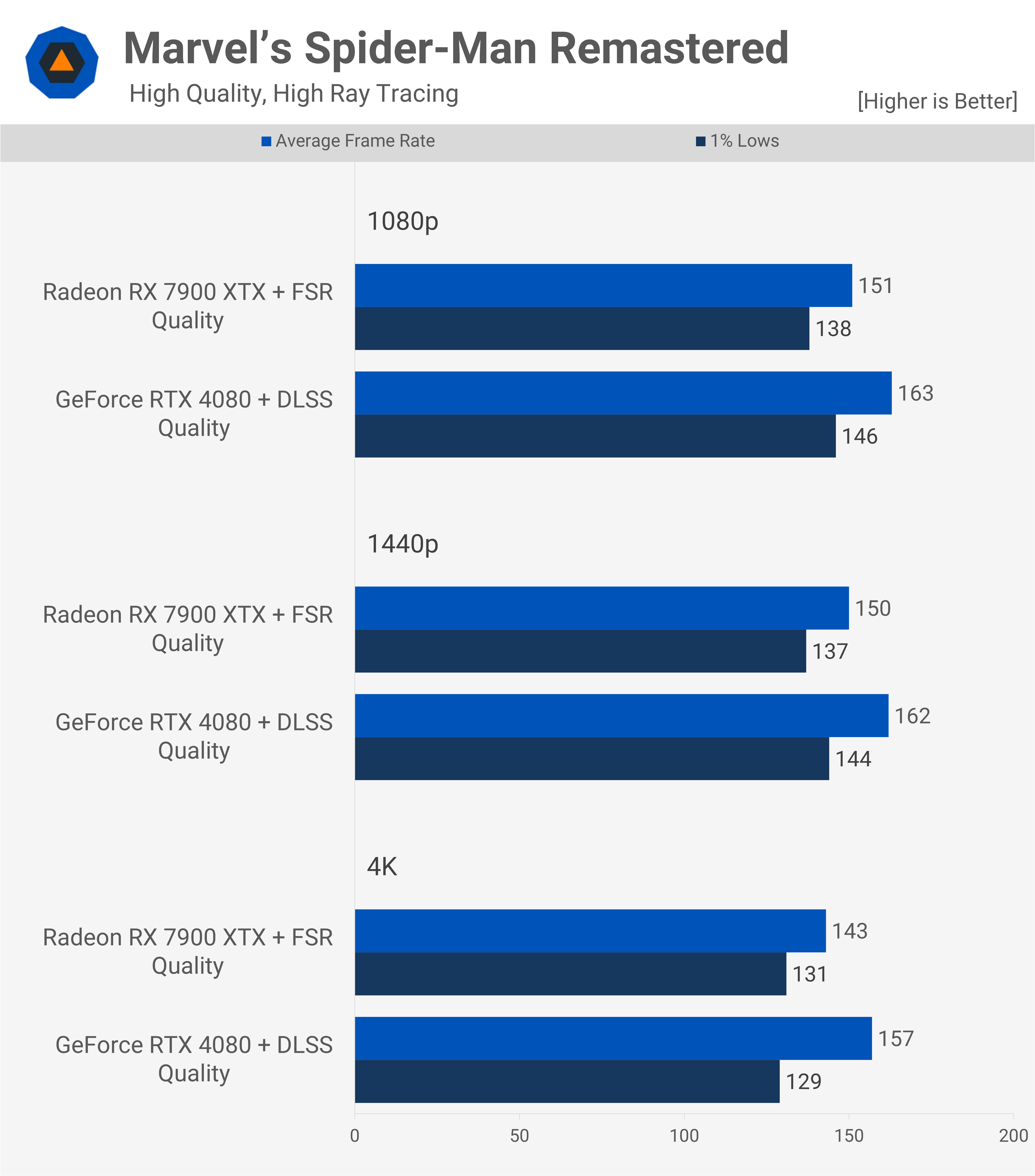
With upscaling activated, the RTX 4080 became mostly CPU-bound, even at 4K, which is astounding. At 4K, the 4080 witnessed a 32% performance surge with DLSS, while the 7900 XTX only had a 17% boost. Generally, DLSS and FSR scale comparably, but we’ve noticed instances where GeForce GPUs outperform Radeon GPUs with FSR. There’s a high likelihood the RTX 4080 would have mirrored these results with FSR, although image quality might vary, particularly at lower resolutions like 1080p.
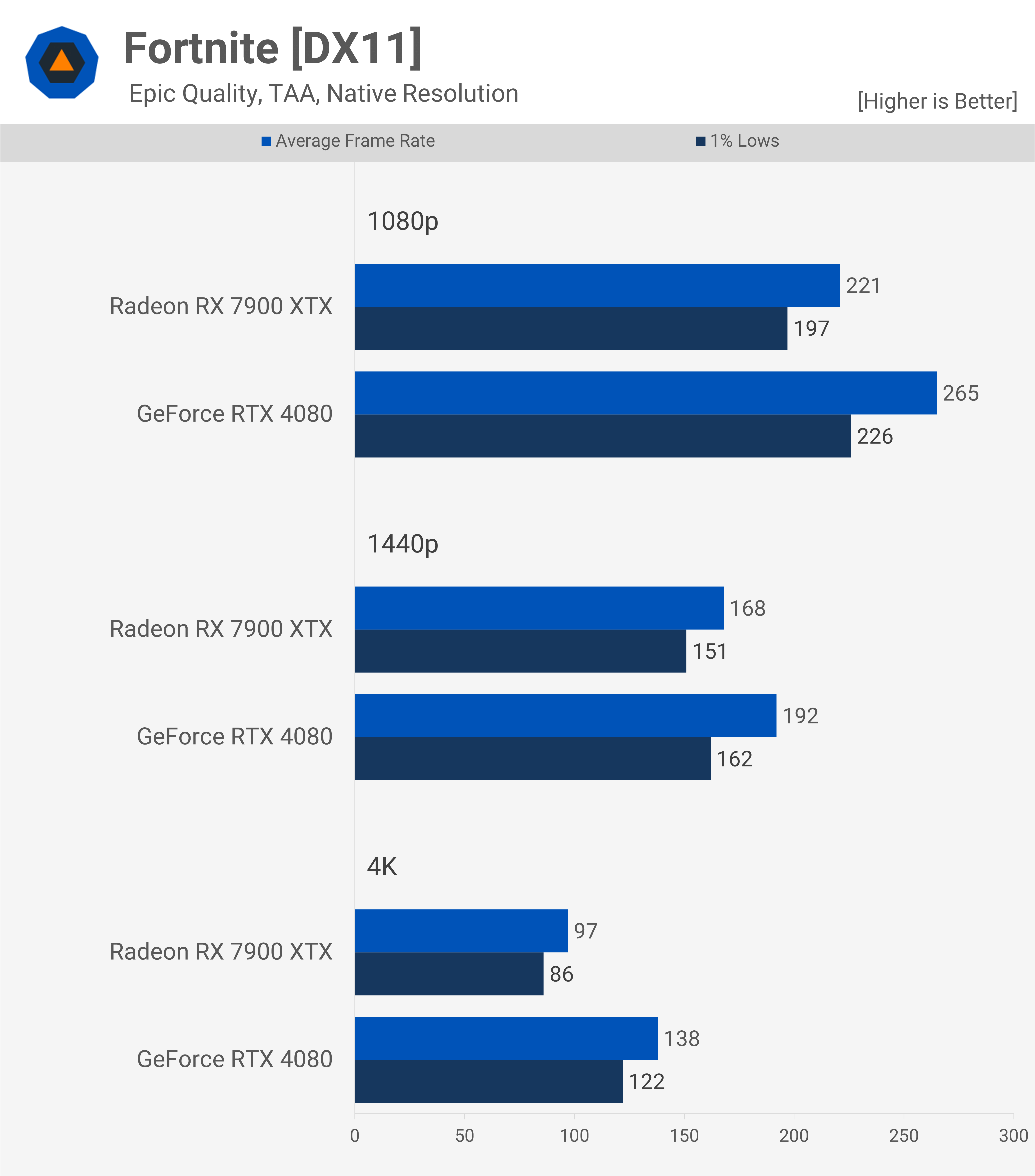
Transitioning to Fortnite, we began with DirectX 11 performance under the epic quality setting. Generally, competitive gamers favor DX11 for consistent frame performance, reflected in the game’s performance mode. Here, the GeForce GPU held a significant edge: 20% at 1080p, 14% at 1440p, and a whopping 42% at 4K.

However, Radeon GPUs typically excel with DX12, which we observed here. The 7900 XTX and RTX 4080 were almost equal in performance, even with hardware ray tracing enabled, and settings like Lumen and Nanite set to Epic.
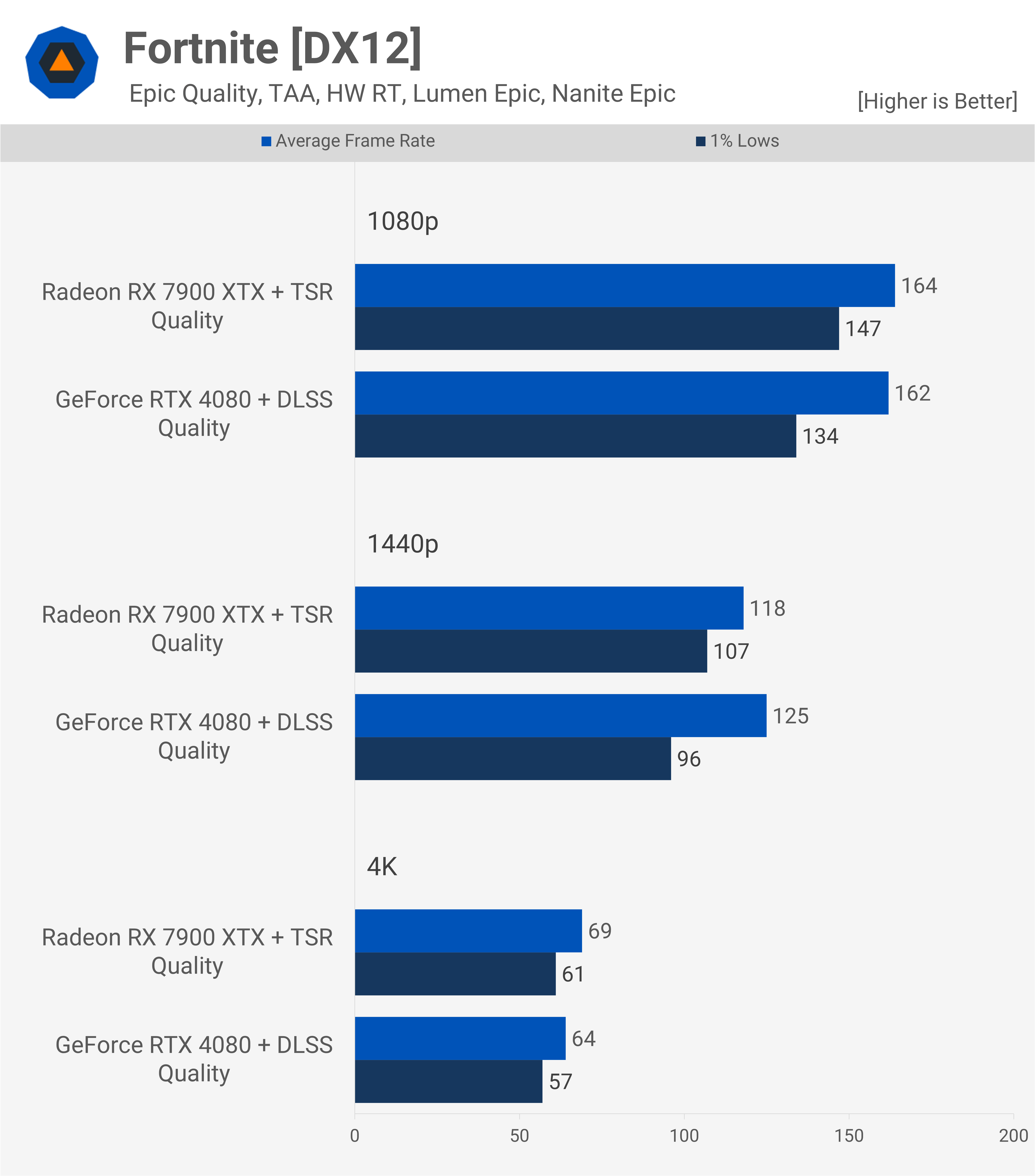
When upscaling was enabled, results were intriguing. The game doesn’t support FSR, so we utilized TSR with the Radeon GPU. At 1440p, the RTX 4080 slightly pulled ahead, though with minor inconsistencies in 1% lows. At 4K, the 7900 XTX had a 47% boost from TSR, while the RTX 4080 had only a 33% increase. This shift granted the Radeon GPU an 8% lead at this high resolution.
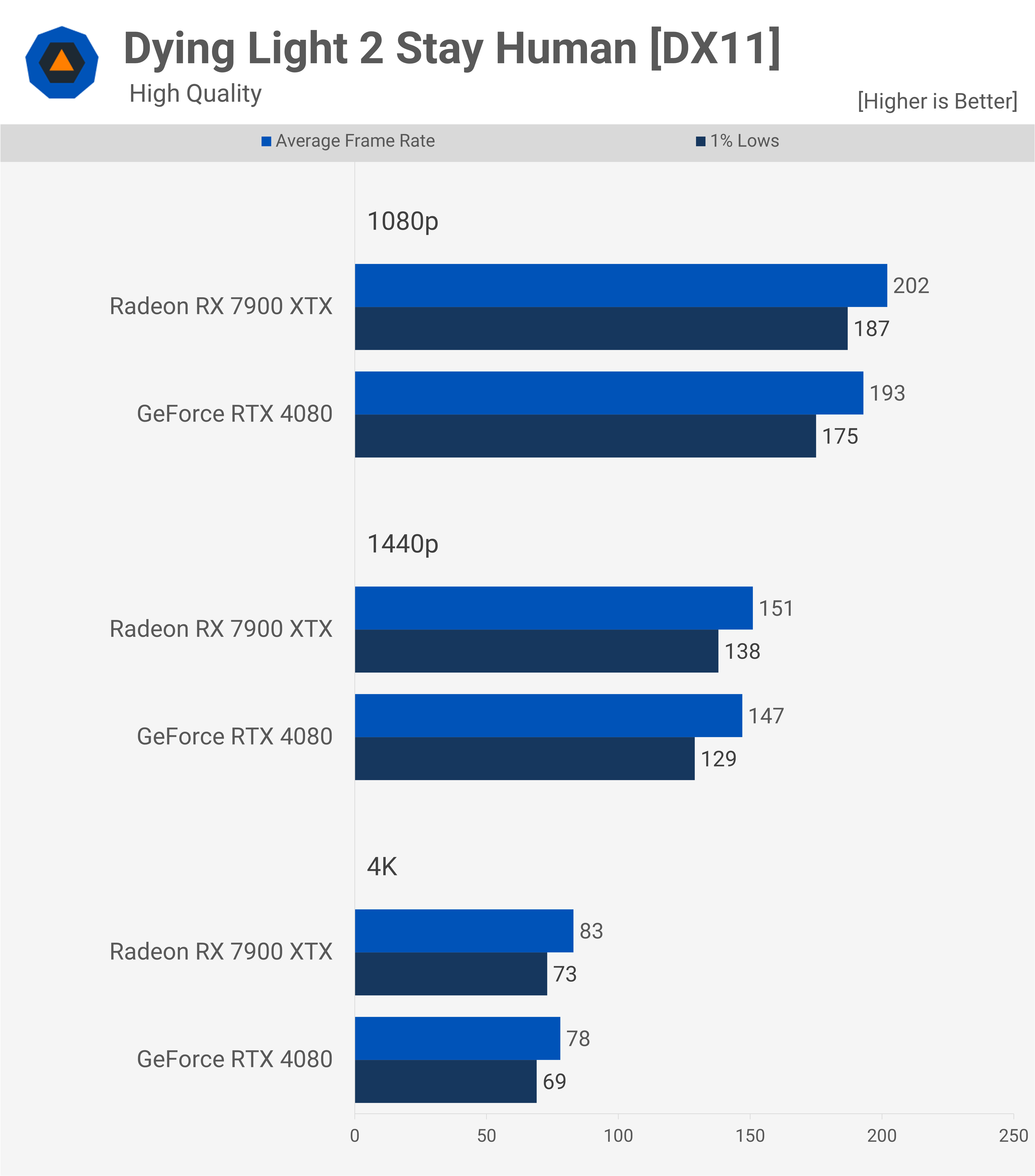

In Dying Light 2 Stay Human, with the high preset (which defaults to DX11), the 7900 XTX slightly outperformed the RTX 4080 across all tested resolutions, indicating a positive outcome for AMD. However, ray tracing dramatically altered the landscape. The 4080 became the front runner: 39% faster at 1080p, 38% at 1440p, and 31% at 4K.

With FSR and DLSS quality upscaling activated, the RTX 4080 maintained its lead: 36% at 1080p, 33% at 1440p, and 30% at 4K. Upscaling results favored the Radeon GPU compared to native resolutions, but the differences were marginal.
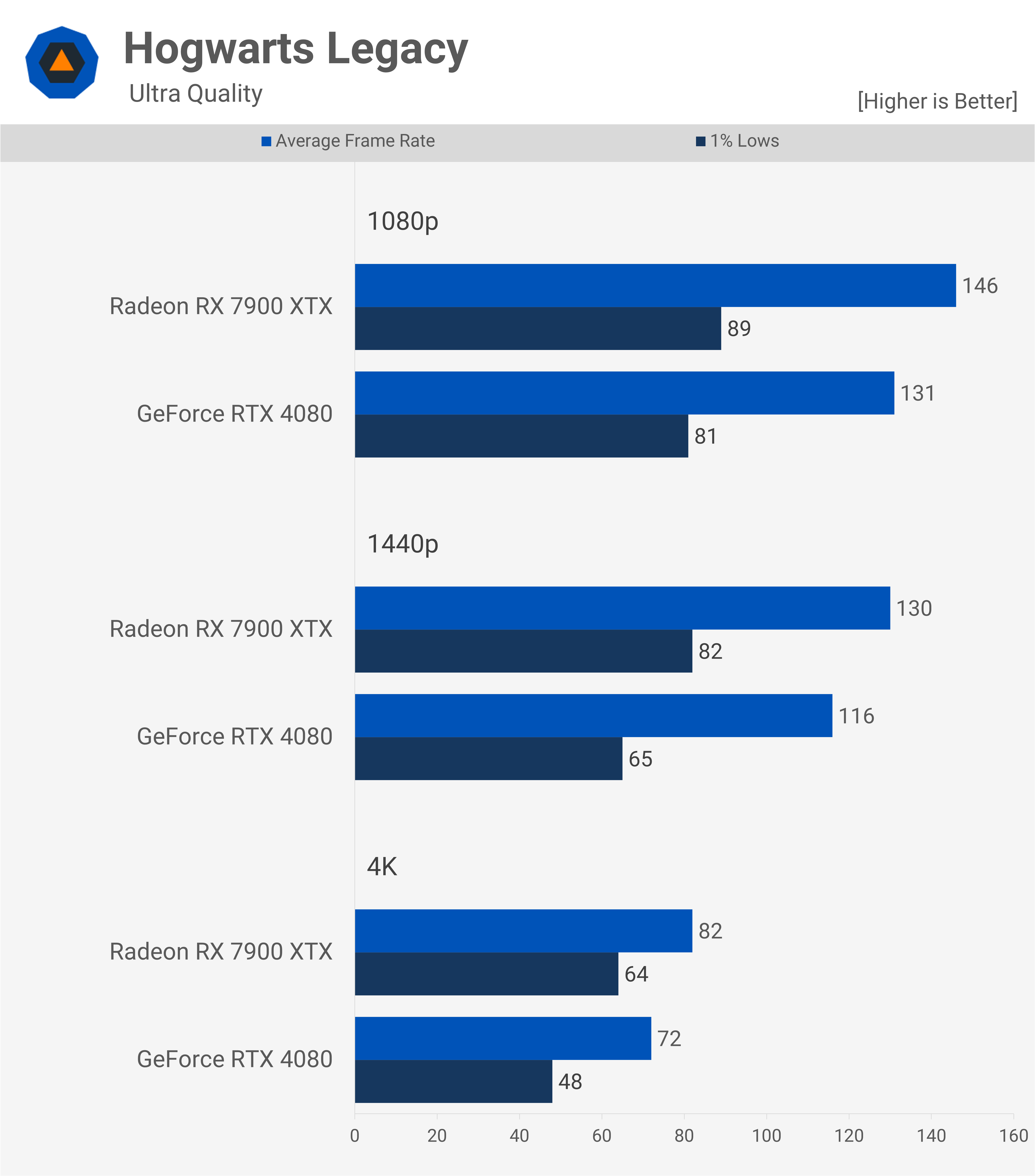
Lastly, we explored Hogwarts Legacy. With the ultra preset, the 7900 XTX dominated with 146 fps at 1080p, making it 11% faster than the RTX 4080. This lead persisted at 1440p (12% faster) and 4K (14%).
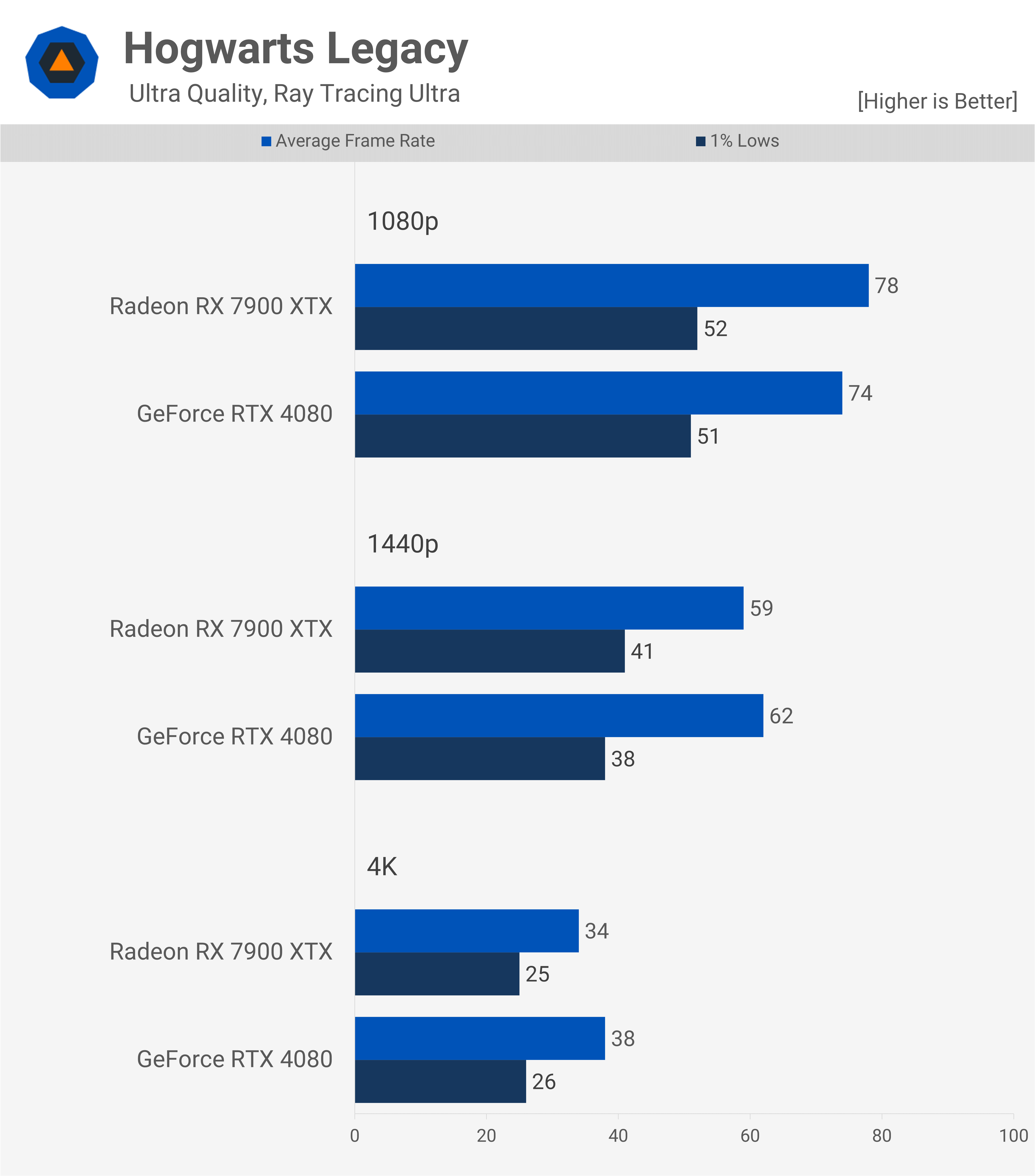
Enabling ray tracing brought the 4080 closer, resulting in a tight competition between the GPUs.
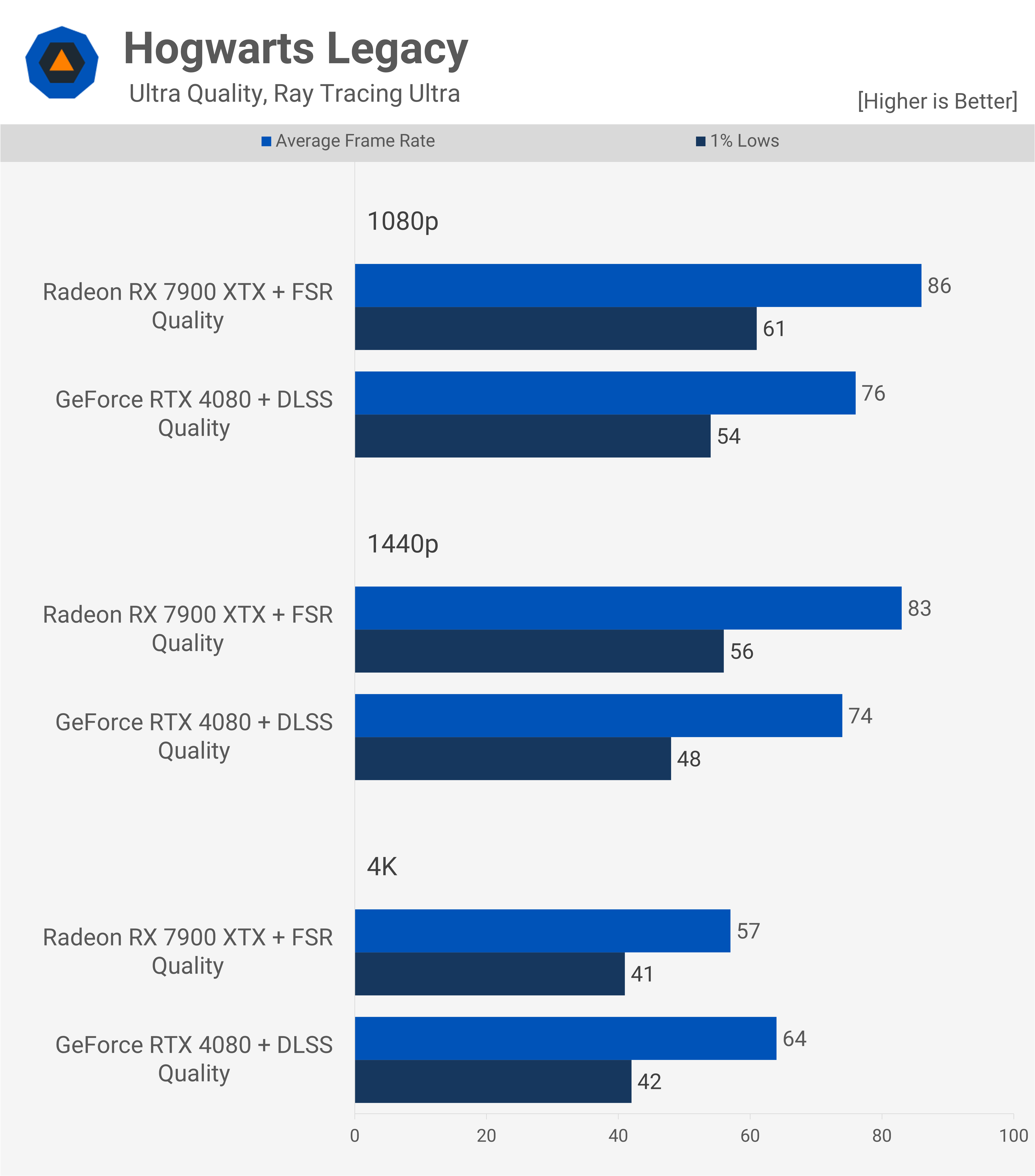
When upscaling was activated with DLSS and FSR, results at 1080p were largely CPU-limited. However, at 1440p, the Radeon GPU gained a 12% lead with ray tracing enabled. At 4K, the RTX 4080 reversed this trend, outperforming the Radeon GPU by 12%.
Performance Summary

Across the 17 games tested, for rasterization-only performance the Radeon 7900 XTX was on average just 3% faster. The only real outliers were F1 23 where the Radeon GPU was 26% faster and Fortnite using DX11 where it was 17% slower.

Earlier in the year we put together a 50 game benchmark between these two GPUs and found that on average at 1440p they delivered the same performance. This time with far fewer games, but with a number of newer titles and of course the latest drivers, the Radeon 7900 XTX ended up coming out on top by a 4% margin, though anything within 5% we deem a tie.

At 4K the Radeon GPU was 7% faster on average. At this point the difference is starting to become noteworthy, and if it wasn’t for the massive loss in Fortnite it would have almost got to double digits.
Performance Summary: Ray-Tracing

Now looking at just the ray tracing results where we have 13 games tested, the Radeon 7900 XTX was on average 8% slower, so the results have been flipped and then some. There are too many titles where the Radeon GPU gets destroyed by the GeForce RTX such as Ratchet & Clank, Cyberpunk and Dying Light 2 as the worst examples.
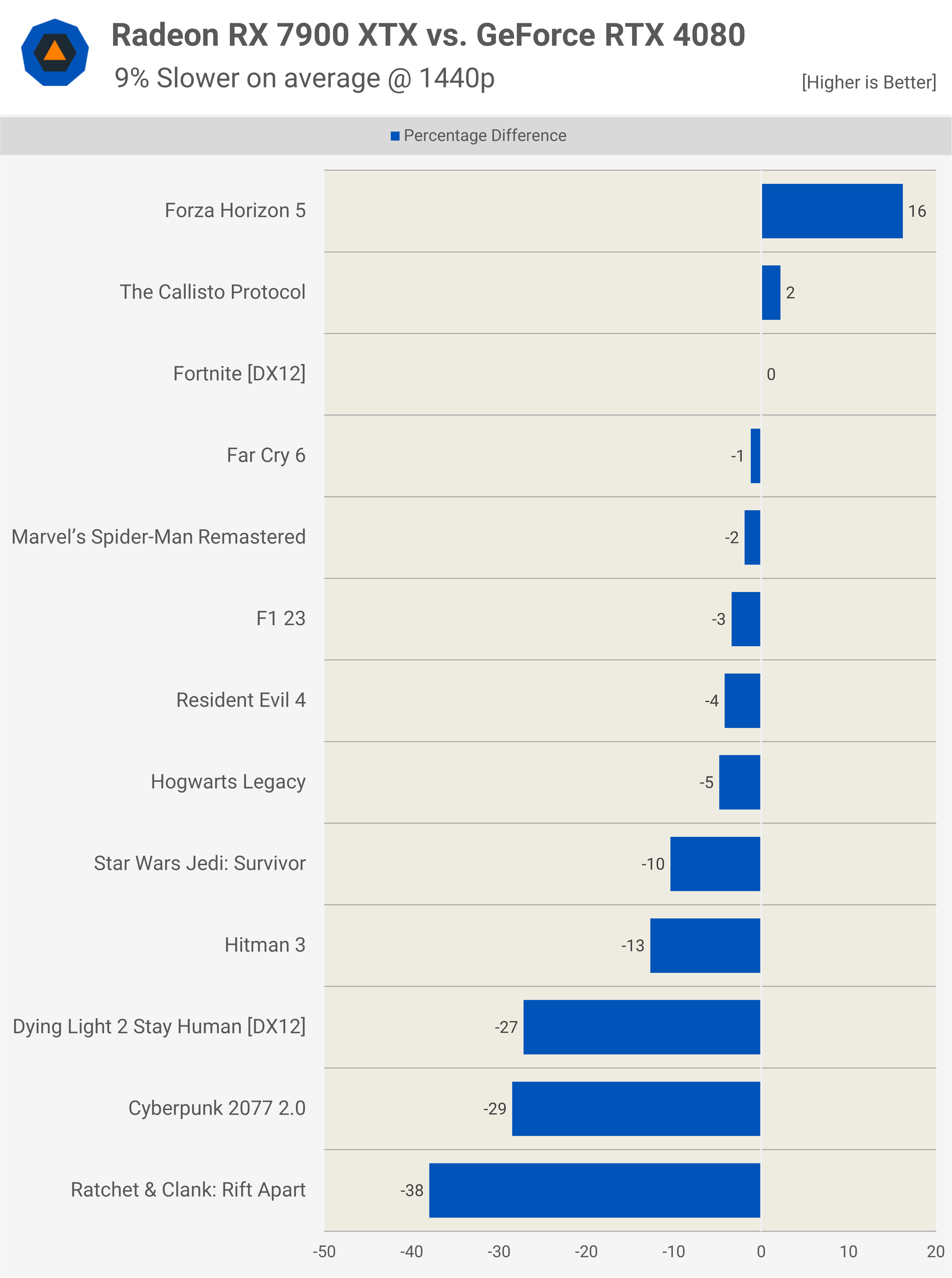
Things don’t improve at 1440p and now the 7900 XTX was on average 9% slower, though a good result in Forza helped and close calls in The Callisto Protocol, Fortnite, Far Cry 6, Spider-Man, F1 23, Resident Evil 4 and Hogwarts Legacy all stopped the Radeon GPU from getting completely ran over.
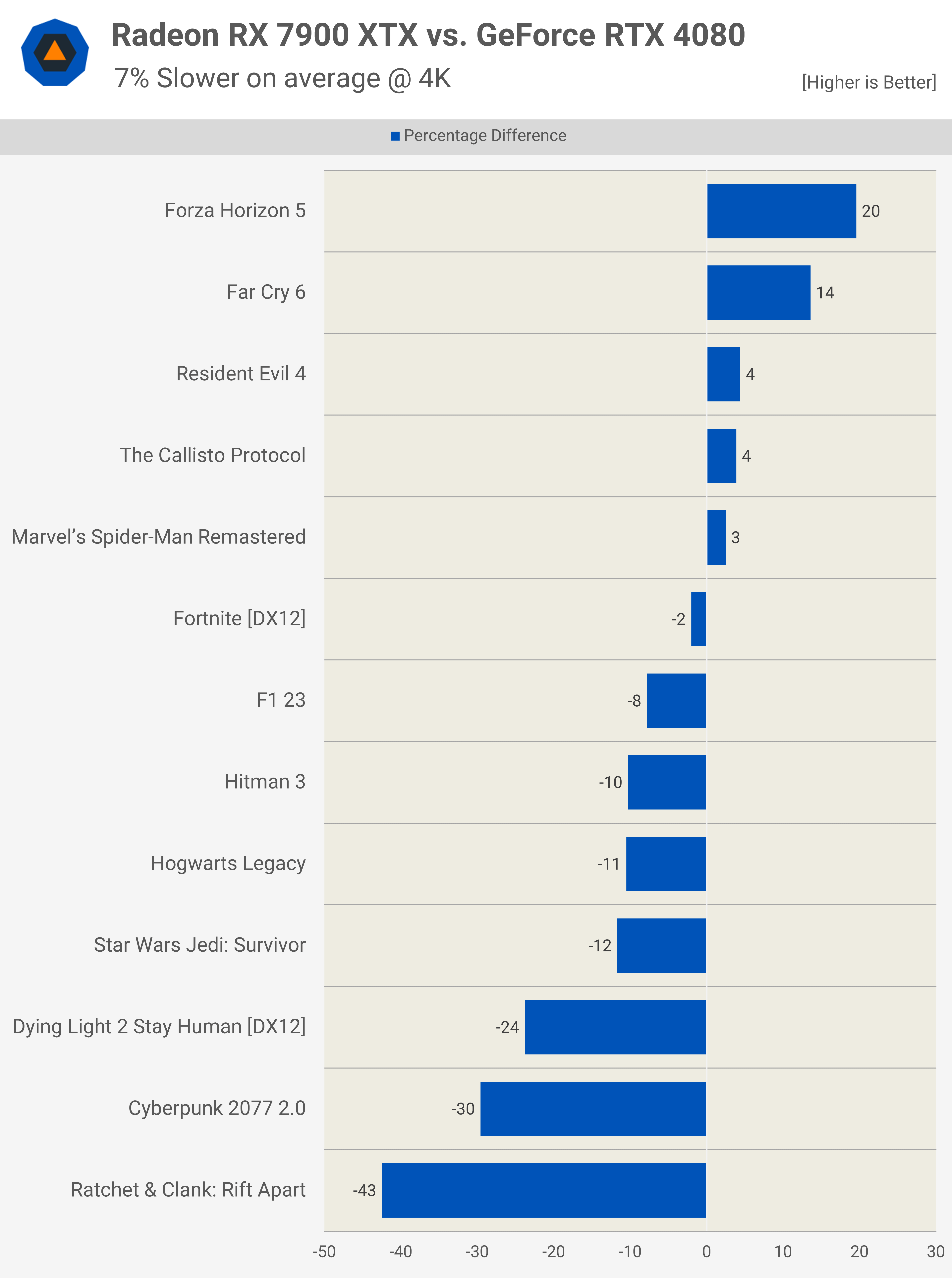
We find more of the same at 4K, here the 7900 XTX was 7% slower on average and while there is some shuffling of the margins, overall the results are much the same. The biggest change is seen when looking at the Far Cry 6 data, the 7900 XTX goes from 1% slower at 1440p to 14% faster at 4K, so this could be down to memory bandwidth.
Performance Summary: Ray Tracing + Upscaling

Now if we include the upscaled ray tracing data at 1080p, which cuts us down to just 10 titles as not all games support DLSS such as The Callisto Protocol, we find that the 7900 XTX is now 9% slower on average. That’s not to say this is a scaling issue with FSR though as the games list has changed, though we did see a few examples where FSR didn’t behave as expected.

At 1440p the Radeon GPU slips to come in 11% slower and again it’s Ratchet and Clank, Cyberpunk and Dying Light 2 where the 7900 XTX really gets rolled by the GeForce.

Finally at 4K, the Radeon 7900 XTX is again 11% slower on average, and this result is helped by strong performance by the Nvidia camp in Fortnite and Forza Horizon 5.
And the Winner Is…
As we mentioned at the outset of this review, considering the best pricing for each GPU, the Radeon 7900 XTX is 15% more affordable than the GeForce RTX 4080. In terms of rasterization performance, the Radeon GPU often outperforms the RTX, particularly at 4K where it was 7% faster on average. In some games, this margin exceeded 20%. However, the difference at 1080p and 1440p were negligible, even if the Radeon had a slight edge.
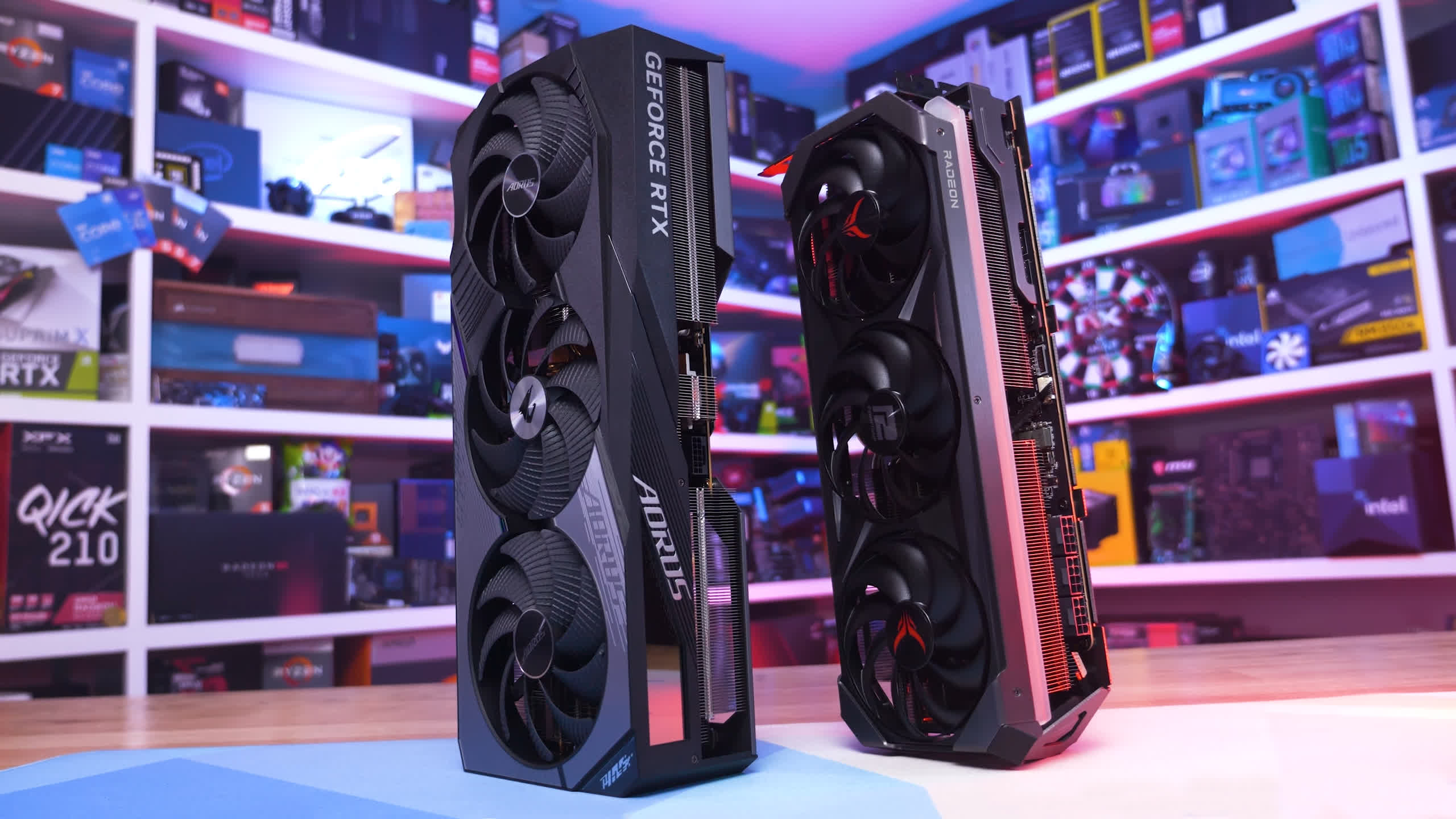
This makes the Radeon GPU a solid value proposition. But if you’re interested in ray tracing performance, then the landscape becomes murkier. With upscaling turned on, the 7900 XTX lagged by an average of 11% in ray tracing, and in certain games, it was more than 20% slower. Ratchet & Clank stood out as the most pronounced disparity, while Dying Light 2 and Cyberpunk also presented challenges for the Radeon GPU.
Taking that into account, we believe the Radeon 7900 XTX should be at least 15% cheaper to truly rival the RTX 4080 and compete for your money against the RTX 4080.
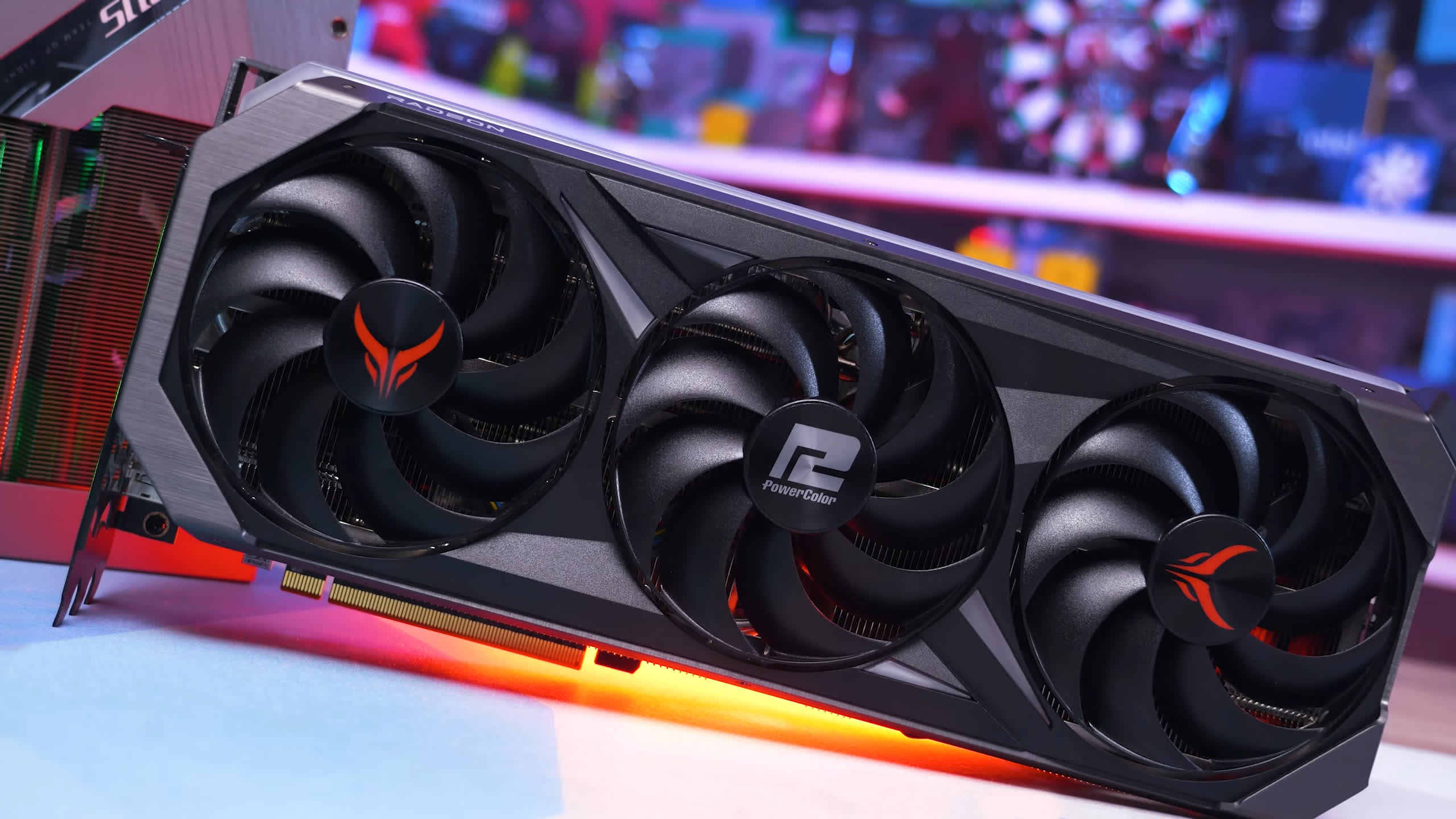
One advantage of the Radeon 7900 XTX is the extra VRAM, jumping from 16GB to 24GB – a significant 50% increase. While impressive on paper for the Radeon GPU, it remains to be seen if this will be a determining factor within the realistic lifespan of these products.
On the downside, the 7900 XTX sometimes pushes up total system power usage by around 15%, or approximately 60 watts. However, in our initial review we identified instances where power consumption was similar, so this shouldn’t be a deciding factor for these models.
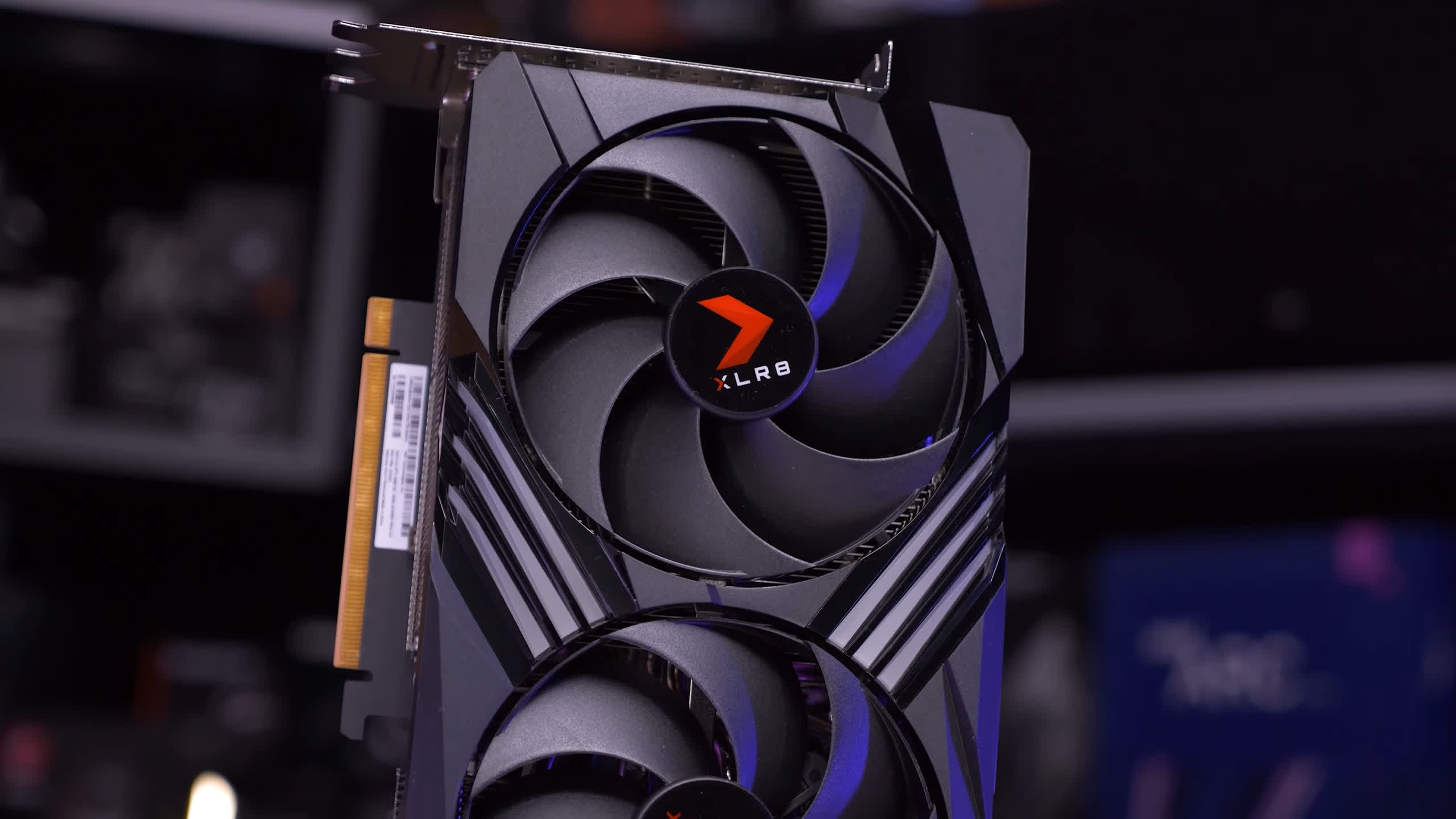
The GeForce RTX 4080 boasts superior upscaling technology. While DLSS doesn’t always vastly outshine competitors, it consistently provides the best image quality, particularly at lower resolutions like 1440p and potentially 1080p, , though we don’t necessarily recommend it there.
The RTX 4080 also excels in ray tracing performance. With the recent introduction of ray reconstruction, there’s potential for even better quality ray tracing, though this remains to be fully realized. Given that ray reconstruction is still in its infancy, we anticipate broader support in the upcoming months.
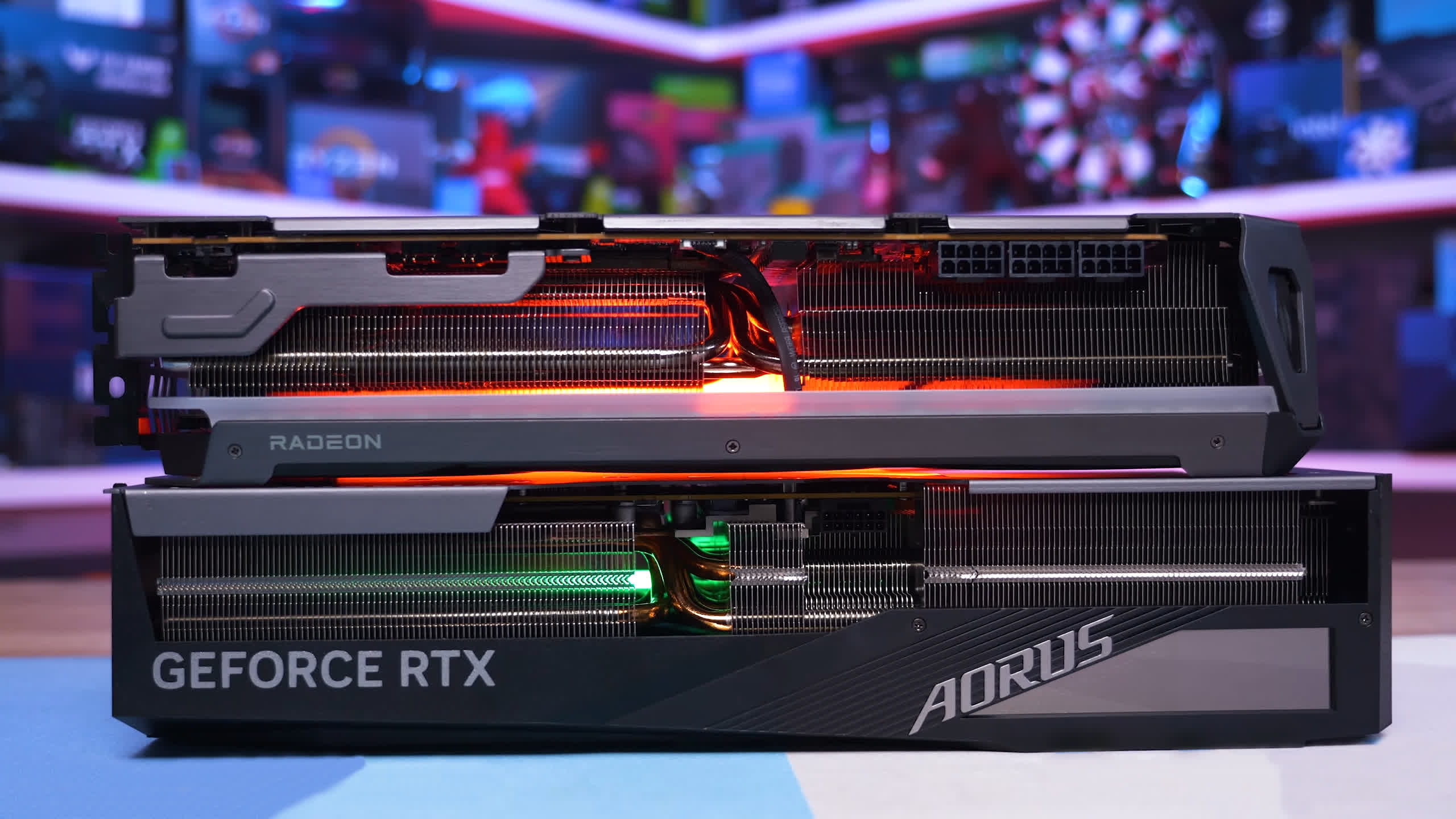
Another feature is DLSS Frame Generation, which can be viewed as a frame-smoothing technology. It elevates visuals by simulating the effects of higher frame rates. Frame Gen proves beneficial for specific single-player games when base frame rates hover around 60 fps. While not a perfect substitute for true high-refresh-rate gameplay, it does improve the experience in certain contexts.
However, this technology is best suited for single-player games. For those primarily invested in competitive shooters, current frame generation technologies might not offer tangible benefits. On a related note, AMD recently launched FSR 3, available in two unexciting games, and we’re currently well into testing it out, so we’re not going to say anything more about it here.
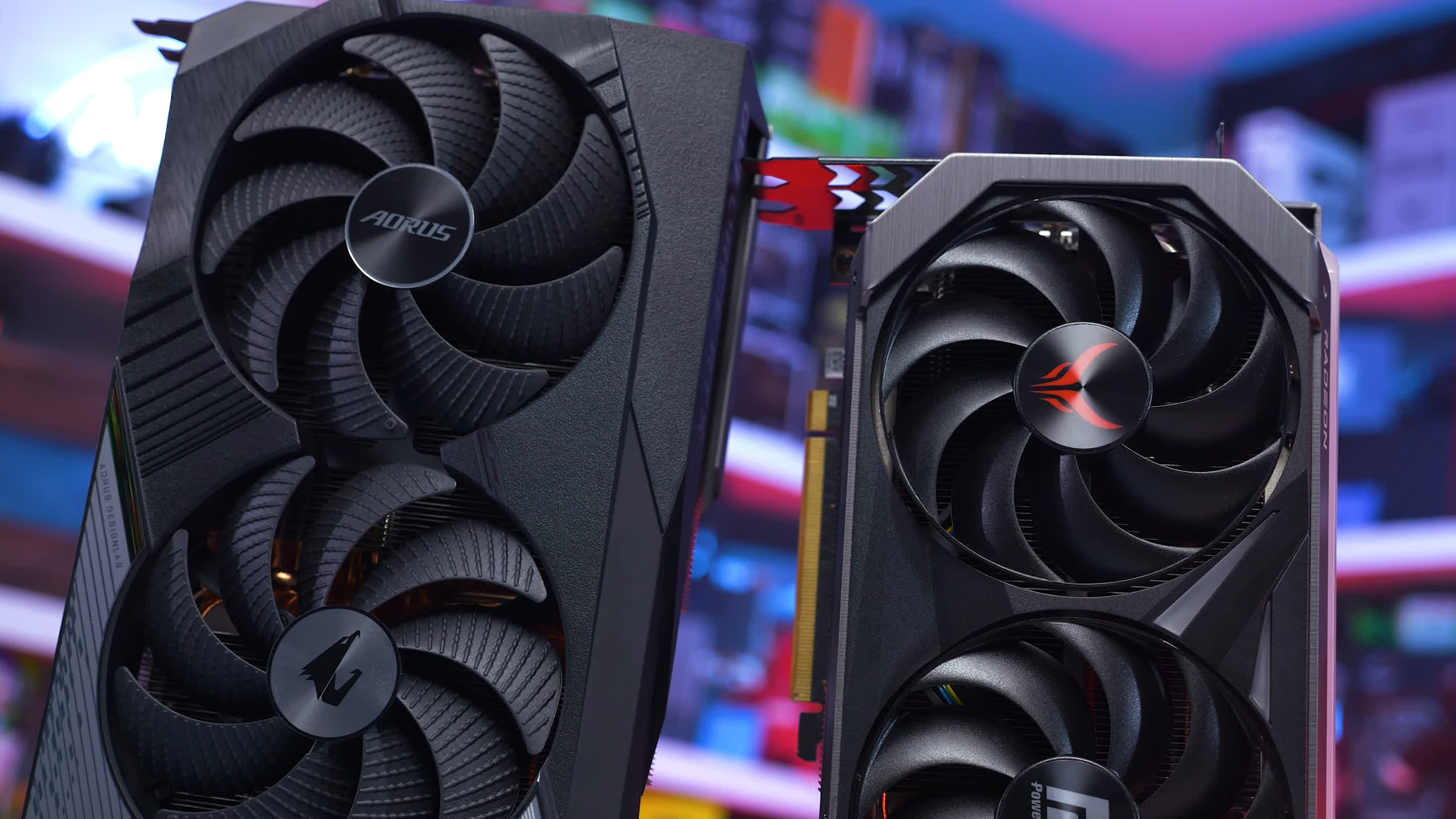
Bottom line, with a 15% discount, the Radeon 7900 XTX stands as a considerable alternative to the RTX 4080, but it’s not an automatic choice. With the most affordable 4080s priced around $1,090, we believe the 7900 XTX should be around $900 to be the preferred choice, and the PowerColor Hellhound is nearly there. We hope this is useful during the holiday season, so you know how these GPUs need to be priced to get the best bang for your buck.
Shopping Shortcuts:
- Nvidia GeForce RTX 4080 on Amazon
- AMD Radeon RX 7900 XTX on Amazon
- Nvidia GeForce RTX 4070 on Amazon
- AMD Radeon RX 7800 XT on Amazon
- Nvidia GeForce RTX 4060 Ti on Amazon
- Nvidia GeForce RTX 4070 Ti on Amazon
- AMD Radeon RX 7900 XT on Amazon
- AMD Radeon RX 7600 on Amazon
- Nvidia GeForce RTX 4090 on Amazon

